#but it will ALSO follow a titular character who will be a major or minor addition to the story just depending on which one it is
Explore tagged Tumblr posts
Text
I know I'm working on so many goddamn things but! I've been thinking about Steam Train and it's gonna get a bit of an overhaul~ ✨
#nyssa rambles#not sure if I've really talked about ST much on here#But!!#basically it was going to be a regular novel with a female protag and her sidekick#but it wasn't going well#so later on#I wrote a steampunk fairytale roughly in the same setting as that OG novel#and I really loved the world I built and wanted to expand on it#so I decided to merge the two ideas#and make a short story anthology featuring different characters#well#that idea went a lot further but#I ended up running into the issue that like#the initial premise for these stories actually taking place is still far too interesting to ignore#so I'm...remerging the ideas I guess?#it'll still more or less be a short story anthology#but it will ALSO follow a titular character who will be a major or minor addition to the story just depending on which one it is#but the stories themselves will all push that character's narrative forward#so it'll kinda like...give me some direction on what the fuck to even write about#while still satisfying that need to explain the backround stuff#and also the need to write about my old protag who is now a different character actually#idk when I'll ever work on this one but#I might ramble about it a bit more when I get more details done ✨#I still need to work on CFR which I'm...stuck™ on#I need someone to talk to about my writing so I can ramble my way out of my mental blocks... ;w;
0 notes
Text
Queering kinship in "The Maiden who Seeks her Brothers" (A)
As I promised before, I will share with you some of the articles contained in the queer-reading study-book "Queering the Grimms". Due to the length of the articles and Tumblr's limitations, I will have to fragment them. Let's begin with an article from the Faux Feminities segment, called Queering Kinship in "The Maiden who Seeks her Brothers", written by Jeana Jorgensen. (Illustrations provided by me)

The fairy tales in the Kinder- und Hausmärchen, or Children’s and Household Tales, compiled by Jacob and Wilhelm Grimm are among the world’s most popular, yet they have also provoked discussion and debate regarding their authenticity, violent imagery, and restrictive gender roles. In this chapter I interpret the three versions published by the Grimm brothers of ATU 451, “The Maiden Who Seeks Her Brothers,” focusing on constructions of family, femininity, and identity. I utilize the folkloristic methodology of allomotific analysis, integrating feminist and queer theories of kinship and gender roles. I follow Pauline Greenhill by taking a queer view of fairy tale texts from the Grimms’ collection, for her use of queer implies both “its older meaning as a type of destabilizing redirection, and its more recent sense as a reference to sexualities beyond the heterosexual.” This is appropriate for her reading of “Fitcher’s Bird” (ATU 311, “Rescue by the Sister”) as a story that “subverts patriarchy, heterosexuality, femininity, and masculinity alike” (2008, 147). I will similarly demonstrate that “The Maiden Who Seeks Her Brothers” only superficially conforms to the Grimms’ patriarchal, nationalizing agenda, for the tale rather subversively critiques the nuclear family and heterosexual marriage by revealing ambiguity and ambivalence. The tale also queers biology, illuminating transbiological connections between species and a critique of reproductive futurism. Thus, through the use of fantasy, this tale and fairy tales in general can question the status quo, addressing concepts such as self, other, and home.
The first volume of the first edition of the Grimm brothers’ collection ap[1]peared in 1812, to be followed by six revisions during the brothers’ lifetimes (leading to a total of seven editions of the so-called large edition of their collection, while the so-called small edition was published in ten editions). The Grimm brothers published three versions of “The Maiden Who Seeks Her Brothers” in the 1812 edition of their collection, but the tales in that volume underwent some changes over time, as did most of the tales. This was partially in an effort to increase sales, and Wilhelm’s editorial changes in particular “tended to make the tales more proper and prudent for bourgeois audiences” (Zipes 2002b, xxxi). “The Maiden Who Seeks Her Brothers” is one of the few tale types that the Grimms published multiply, each time giving titular focus to the brothers, as the versions are titled “The Twelve Brothers” (KHM 9), “The Seven Ravens” (KHM 25), and “The Six Swans” (KHM 49). However, both Stith Thompson and Hans-Jörg Uther, in their respective 1961 and 2004 revisions of the international tale type index, call the tale type “The Maiden Who Seeks Her Brothers.” Indeed, Thompson discusses this tale in The Folktale under the category of faithfulness, par[1]ticularly faithful sisters, noting, “In spite of the minor variations . . . the tale-type is well-defined in all its major incidents” (1946, 110). Thompson also describes how the tale is found “in folktale collections from all parts of Europe” and forms the basis of three of the tales in the Grimm brothers’ collection (111).
In his Interpretation of Fairy Tales, Bengt Holbek classifies ATU 451 as a “feminine” tale, since its two main characters who wed at the end of the tale are a low-born young female and a high-born young male (the sister, though originally of noble birth in many versions, is cast out and essentially impoverished by the tale’s circumstances). Holbek notes that the role of a low-born young male in feminine tales is often filled by brothers: “The relationship between sister and brothers is characterized by love and help[1]fulness, even if fear and rivalry may also be an aspect in some tales (in AT 451, the girl is afraid of the twelve ravens; she sews shirts to disenchant them, however, and they save her from being burnt at the stake at the last moment)” (1987, 417). While Holbek conflates tale versions in this description, he is essentially correct about ATU 451; the siblings are devoted to one another, despite fearsome consequences.
The discrepancy between those titles that focus on the brothers and those that focus on the sister deserves further attention. Perhaps the Grimm brothers (and their informants?) were drawn to the more spectacular imagery of enchanted brothers. In Hans Christian Andersen’s well-known version of ATU 451, “The Wild Swans,” he too focuses on the brothers in the title. However, some scholars, including Thompson and myself, are more intrigued by the sister’s actions in the tale. Bethany Joy Bear, for instance, in her analysis of traditional and modern versions of ATU 451, concentrates on the agency of the silent sister-saviors, noting that the three versions in the Grimms’ collection “illustrate various ways of empowering the hero[1]ine. In ‘The Seven Ravens’ she saves her brothers through an active and courageous quest, while in ‘The Twelve Brothers’ and ‘The Six Swans’ her success requires redemptive silence” (2009, 45).
The three tales differ by more than just how the sister saves her brothers, though. In “The Twelve Brothers,” a king and queen with twelve boys are about to have another child; the king swears to kill the boys if the newborn is a girl so that she can inherit the kingdom. The queen warns the boys and they run away, and the girl later seeks them. She inadvertently picks flowers that turn her brothers into ravens, and in order to disenchant them she must remain silent; she may not speak or laugh for seven years. During this time, she marries a king, but his mother slanders her, and when the seven years have elapsed, she is about to be burned at the stake. At that moment, her brothers are disenchanted and returned to human form. They redeem their sister, who lives happily with her husband and her brothers.
In “The Seven Ravens,” a father exclaims that his seven negligent sons should turn into ravens for failing to bring water to baptize their newborn sister. It is unclear whether the sister remains unbaptized, thus contributing to her more liminal status. When the sister grows up, she seeks her brothers, shunning the sun and moon but gaining help from the stars, who give her a bone to unlock the glass mountain where her brothers reside. Because she loses the bone, the girl cuts off her small finger, using it to gain access to the mountain. She disenchants her brothers by simply appearing, and they all return home to live together.
In “The Six Swans,” a king is coerced into marrying a witch’s daughter, who finds where the king has stashed his children to keep them safe. The sorceress enchants the boys, turning them into swans, and the girl seeks them. She must not speak or laugh for six years and she must sew shirts from asters for them. She marries a king, but the king’s mother steals each of the three children born to the couple, smearing the wife’s mouth with blood to implicate her as a cannibal. She finishes sewing the shirts just as she’s about to be burned at the stake; then her brothers are disenchanted and come to live with the royal couple and their returned children. However, the sleeve of one shirt remained unfinished, so the littlest brother is stuck with a wing instead of an arm.
The main episodes of the tale type follow Russian folklorist Vladimir Propp’s structural sequence for fairy-tale plots: the tale begins with a villainy, the banishing and enchantment of the brothers, sometimes resulting from an interdiction that has been violated. The sister must perform a task in addition to going on a quest, and the tale ends with the formation of a new family through marriage. As Alan Dundes observes, “If Propp’s formula is valid, then the major task in fairy tales is to replace one’s original family through marriage” (1993, 124; see also Lüthi 1982). This observation holds true for heteronormative structures (such as the nuclear family), which exist in order to replicate themselves. In many fairy tales, the original nuclear family is discarded due to circumstance or choice. However, the sister in “The Maiden Who Seeks Her Brothers” has not abandoned or been removed from her old family, unlike Cinderella, who ditches her nasty stepmother and stepsisters, or Rapunzel, who is taken from her birth parents, and so on. Although, admittedly, “The Seven Ravens” does not end in marriage, I do not plan to disqualify it from analysis simply because it doesn’t fit the dominant model, as Bengt Holbek does when comparing Danish versions of “King Wivern” (ATU 433B, “King Lindorm”).1 The fact that one of the tales does not end in marriage actually supports my interpretation of the tales as transgressive, a point to which I will return later.

Dundes’s (2007) notion of allomotif helps make sense of the kinship dynamics in “The Maiden Who Seeks Her Brothers.” In order to decipher the symbolic code of folktales, Dundes proposes that any motif that could fill the same slot in a particular tale’s plot should be designated an allomotif. Further, if motif A and motif B fulfill the same purpose in moving along the tale’s plot, then they are considered mutually substitutable, thus equivalent symbolically. What this assertion means for my analysis is that all the methods by which the brothers are enchanted and subsequently disenchanted can be treated as meaningful in relation to one another. One of the advantages of comparing allomotifs rather than motifs is that we can be assured that we are analyzing not random details but significant plot components. So in “The Six Swans” and “The Seven Ravens,” we see the parental curse causing both the banishment and the enchantment of the brothers, whereas in “The Twelve Brothers,” the brothers are banished and enchanted in separate moves. Even though the brothers’ exile and enchantment happen in a different sequence in the different texts, we must view their causes as functionally parallel. Thus the ire of a father concerned for his newborn daughter, the jealous rage of a stepmother, the homicidal desire of a father to give his daughter everything, and the innocent flower gathering of a sister can all be seen as threatening to the brothers. All of these actions lead to the dispersal and enchantment of the brothers, though not all are malicious, for the sister in “The Twelve Brothers” accidentally turns her brothers into ravens by picking flowers that consequently enchant them.
I interpret this equivalence as a metaphorical statement—threats to a family’s cohesion come in all forms, from well-intentioned actions to openly malevolent curses. The father’s misdirected love for his sole daughter in two versions (“The Twelve Brothers” and “The Seven Ravens”) translates to danger to his sons. This danger is allomotifically paralleled by how the sister, without even knowing it, causes her brothers to become enchanted, either by picking flowers in “The Twelve Brothers” or through the mere incident of her birth in “The Twelve Brothers” and “The Seven Ravens.” The fact that a father would prioritize his sole daughter over numerous sons is strange and reminiscent of tales in which a father explicitly expresses romantic de[1]sire for his daughter, as in “Allerleirauh” (ATU 510B), discussed in chapter 4 by Margaret Yocom. Even in “The Six Swans,” where a stepmother with magical powers enchants the sons, the father is implicated; he did not love his children well enough to protect them from his new spouse, and once the boys had been changed into swans and fled, the father tries to take his daughter with him back to his castle (where the stepmother would likely be waiting to dispose of the daughter as well), not knowing that by asserting control over her, he would be endangering her. The father’s implied ownership of the daughter in “The Maiden Who Seeks Her Brothers” and the linking of inheritance with danger emphasize the conflicts that threaten the nuclear family. Both material and emotional resources are in limited supply in these tales, with disastrous consequences for the nuclear family, which fragments, as it does in all fairy tales (see Propp 1968).
Holbek reaches a similar conclusion in his allomotific analysis of ATU 451, though he focuses on Danish versions collected by Evald Tang Kristensen in the late nineteenth century. Holbek notes that the heroine is the actual “cause of her brothers’ expulsion in all cases, either—innocently—through being born or—inadvertently—through some act of hers” (1987, 550). The true indication of the heroine’s role in condemning her brothers is her role in saving them, despite the fact that other characters may superficially be blamed: “The heroine’s guilt is nevertheless to be deduced from the fact that only an act of hers can save her brothers.” However, Holbek reads the tale as revolving around the theme of sibling rivalry, which is more relevant to the cultural context in which Danish versions of ATU 451 were set, since the initial family situation in the tale was not always said to be royal or noble, and Holbek views the tales as reflecting the actual concerns and conditions of their peasant tellers (550; see also 406–9).2 Holbek also discusses the lack of resources that might lead to sibling rivalry, identifying physical scarcity and emotional love as two factors that could inspire tension between siblings.
The initial situation in the Grimms’ versions of “The Maiden Who Seeks Her Brothers” is also a comment on the arbitrary power that parents have over their children, the ability to withhold love or resources or both. The helplessness of children before the strong feelings of their parents is cor[1]roborated in another Grimms’ tale, “The Lazy One and the Industrious One” (Zipes 2002b, 638).3 In this tale, which Jack Zipes translated among the “omitted tales” that did not make it into any of the published editions of the KHM, a father curses his sons for insulting him, causing them to turn into ravens until a beautiful maiden kisses them. Essentially, the fam[1]ily is a site of danger, yet it is a structure that will be replicated in the tale’s conclusion . . . almost.
But first, the sister seeks her brothers and disenchants them. The symbolic equation links, in each of the three tales, the sister’s silence (neither speaking nor laughing) for six years while sewing six shirts from asters, her seven years of silence (neither speaking nor laughing), and her cutting off her finger and using it to gain entry to the glass palace where she disenchants her brothers merely by being present. The theme unifying these allomotifs is sacrifice. The sister’s loss of her finger, equivalent to the loss of her voice, is a symbolic disempowerment. One loss is a physical mutilation, which might not impair the heroine terribly much; the choice not to use her voice is arguably more drastic, since her inability to speak for herself nearly causes her death in the tales.4 Both losses could be seen as equivalent to castration.5 However, losing her ability to speak and her ability to manipulate the world around her while at the same time displaying domestic competence in sewing equates powerlessness with feminine pursuits. Bear notes that versions by both the Grimms and Hans Christian Andersen envision “a distinctly feminine savior whose work is symbolized by her spindle, an ancient emblem of women’s work” (2009, 46). Ruth Bottigheimer (1986) points out in her essay “Silenced Women in Grimms’ Tales” that the heroines in “The Twelve Brothers” and “The Six Swans” are forced to accept conditions of muteness that disempower them, which is part of a larger silencing that occurs in the tales; women both are explicitly forbidden to speak, and they have fewer declarative and interrogative speech acts attributed to them within the whole body of the Grimms’ texts.
Ironically, in performing subservient femininity, the sister fails to perform adequately as wife or mother, since the children she bears in one version (“The Six Swans”) are stolen from her. When the sister is married to the king, she gives birth to three children in succession, but each time, the king’s mother takes away the infant and smears the queen’s mouth with blood while she sleeps (Zipes 2002b, 170). Finally, the heroine is sentenced to death by a court but is unable to protest her innocence since she must not speak in order to disenchant her brothers. In being a faithful sister, the heroine cannot be a good mother and is condemned to die for it. This aspect of the tale could represent a deeply coded feminist voice.6 A tale collected and published by men might contain an implicitly coded feminist message, since the critique of patriarchal institutions such as the family would have to be buried so deeply as to not even be recognizable as a message in order to avoid detection and censorship (Radner and Lanser 1993, 6–9). The sis[1]ter in “The Six Swans” cannot perform all of the feminine duties required of her, and because she ostensibly allows her children to die, she could be accused of infanticide. Similarly, in the contemporary legend “The Inept Mother,” collected and analyzed by Janet Langlois, an overwhelmed mother’s incompetence indirectly kills one or all of her children.7 Langlois reads this legend as a coded expression of women’s frustrations at being isolated at home with too many responsibilities, a coded demand for more support than is usually given to mothers in patriarchal institutions. Essentially, the story is “complex thinking about the thinkable—protecting the child who must leave you—and about the unthinkable—being a woman not defined in relation to motherhood” (Langlois 1993, 93). The heroine in “The Six Swans” also occupies an ambiguous position, navigating different expectations of femininity, forced to choose between giving care and nurturance to some and withholding it from others.
Here, I find it productive to draw a parallel to Antigone, the daughter of Oedipus. Antigone defies the orders of her uncle Creon in order to bury her brother Polyneices and faces a death sentence as a result. Antigone’s fidelity to her blood family costs her not only her life but also her future as a productive and reproductive member of society. As Judith Butler (2000) clarifies in Antigone’s Claim: Kinship between Life and Death, Antigone transgresses both gender and kinship norms in her actions and her speech acts. Her love for her brother borders on the incestuous and exposes the incest taboo at the heart of kinship structure. Antigone’s perverse death drive for the sake of her brother, Butler asserts, is all the more monstrous because it establishes aberration at the heart of the norm (in this case the incest taboo). I see a similar logic operating in “The Maiden Who Seeks Her Brothers,” because according to allomotific equivalences, the heroine is condemned to die only in one version (“The Six Swans”) because she allegedly ate her children. In the other version that contains the marriage episode (“The Twelve Brothers”), the king’s mother slanders her, calling the maiden “godless,” and accuses her of wicked things until the king agrees to sentence her to death (Zipes 2002b, 35). As allomotific analysis reveals, in the three versions, the heroine is punished for being excessively devoted to her brothers, which is functionally the same as cannibalism and as being generally wicked (the accusation of the king’s mother in two of the versions).
In a sense, the heroine’s disproportionate devotion to her brothers kills her chance at marriage and kills her children, which from a queer stance is a comment on the performativity of sexuality and gender. According to Butler, gender performativity demonstrates “that what we take to be an internal essence of gender is manufactured through a sustained set of acts, posited through the gendered stylization of the body” ([1990] 1999, xv). This illusion, that gender and sexuality are a “being” rather than a “doing,” is constantly at risk of exposure. When sexuality is exposed as constructed rather than natural, thus threatening the whole social-sexual system of identity formation, the threat must be eliminated.
One aspect of this system particularly threatened in “The Maiden Who Seeks Her Brothers” is reproductive futurism, one form of compulsory teleological heterosexuality, “the epitome of heteronormativity’s desire to reach self-fulfillment by endlessly recycling itself through the figure of the Child” (Giffney 2008, 56; see also Edelman 2004). Reproductive futurism mandates that politics and identities be placed in service of the future and future children, utilizing the rhetoric of an idealized childhood. In his book on reproductive futurism, Lee Edelman links queerness and the death drive, stating, “The death drive names what the queer, in the order of the social, is called forth to figure: the negativity opposed to every form of social viability” (2004, 9). According to this logic, to prioritize anything other than one’s reproductive future is to refuse social viability and heteronormativity—this is what the heroine in “The Maiden Who Seeks Her Brothers” does. Her excessive emotional ties to her brothers disfigure her future, aligning her with the queer, the unlivable, and hence the ungrievable. Refusing the linear narrative of reproductive futurism registers as “unthinkable, irresponsible, inhumane” (4), words that could very well be used to describe a mother who is thought to be eating her babies and who cannot or will not speak to defend herself.
The heroine’s marriage to the king in two versions of the tale can also be examined from a queer perspective. Like the tale “Fitcher’s Bird,” which queers marriage by “showing male-female [marital] relationships as clearly fraught with danger and evil from their onset,” the Grimms’ two versions of ATU 451 that feature marriage call into question its sanctity and safety (Greenhill 2008, 150, emphasis in original). Marriage, though the ultimate goal of many fairy tales, does not provide the heroine with a supportive or nurturing environment. Bear comments that in versions of “The Maiden Who Seeks Her Brothers” wherein a king discovers and marries the heroine, “the king’s discovery brings the sister into a community that both facilitates and threatens her work. The sister’s discovery brings her into a home, foreshadowing the hoped-for happy ending, but it is a false home, determined by the king’s desire rather than by the sister’s creation of a stable and complete community” (2009, 50)

#queering the grimm#queering the grimms#queer fairytales#the maiden who seeks her brothers#the twelve brothers#the six swans#the seven ravens#grimm fairytales#fairytale analysis#fairytale type
20 notes
·
View notes
Text
This is a fascinatingly common theme in Discworld, sans the fully-static aspect. I skimmed the notes and was surprised by the infrequency of mentions (found 2 for Monstrous Regiment, one for Small Gods), so I'm going to bring it up here.
The best examples of this theme for me, generally speaking, are the Death books, because Death is the most common godlike figure to interact with book characters. I say godlike, because Death seems different from other gods on the Disk who typically have followers and worshippers and are named as gods, e.g. the crocodile god Offler, the great god Om, etc. But Death is treated like a god, and subject to the same supernatural rules as the rest of them.
People don't typically worship Death-the-character with ritual, but lowercase-d death is filled with ritual (you see a lot of this in the Witches books)
People believe in Death, and Death's appearance and ideosyncracies are shaped by human beliefs
In the Disk, gods are shaped by believers (so is reality, but we'll focus on gods). The universal nature of death pretty much guarantees people will form supernatural beliefs around it, and people being people, will tend to anthropomorphize death (thus death now involves Death, who is not a personification of dying but a separate figure who enacts death by collecting/guiding/greeting/directing the soul of the dead. When death does this for their body and soul, it is pretty permanent. That same body and soul don't reunite again in the same living way (though reincarnation is possible, as are zombies).
This is a problem because humans' tendency to anthropomorphize Death means that Death is very connected to humans. This pull routinely makes Death human enough to be bad at being a god. Which then tends to suck some other poor soul into the Death-shaped hole.
The most obvious example to me is Soul Music, wherein Susan finds herself becoming Death because Death is grieving and having an existential crisis following the death of Death's adopted children. When a human is drawn to fill a narrative role, there's often tension between their individual, human desires and personality vs the role they are being pulled into playing. The role becomes reality.
I think this comes into play in just about every Death book in some major or minor way. When we see magical-but-human figures or demigod figures* (as Susan becomes), they're interesting in that they're capable of wielding other's expectations to supernatural effect while remaining consciously themselves and thus retaining humanity. True, complete gods, on the other hand, lose this ability to shape themselves and are subject to losing the ability to shape the world around them because they are fundamentally reliant on external believers. You see this in Small Gods, and it's also a theme in Monstrous Regiment. These particular stories tend to be very involved with social critique around the systems we create and under which we rationalize and glorify violence, so the weak god role serves to highlight the disconnect between the cleansed-earth fantasies created by believers/the belief systems people are locked into, and the scorched-earth reality they are actually creating in the name of their god, who is far weaker than their belief in their (belief-reinforcing/policing) system.
Another good literal example of this can be seen in Wintersmith, wherein a certain character puts herself in the symbolic role of a goddess and thus accidentally invites her counterpart into this world, to dangerous affect. She has to figure out how to return the god to the figurative world and avoid getting sucked in herself. Other good examples would be the Moist Von Lipwig books, where the titular character keeps finding himself in Situations and trying really hard to believe that magic isn't real and can't hurt him (it is real and funnily enough the only thing that keeps it from swallowing him is probably a) his wife and b) the fact that he fundamentally does not believe in himself that way; he's very very aware of his own mortality. These things are mutually reinforcing btw. Oh, and his fear of Ventinari, I guess**).
You can very easily extend the theme of deification beyond the scope described in the original post. I won't say it's exactly the same, but it's a similar palette. You see it in witches, whose magic and usefulness depends on the image they cultivate with their villages. It's kept in balance by the actual good they do for people, and it's also kept in check by each other. 'Cackling' can be used to indicate going-too-far, where the witch loses touch with reality and loses herself to the story, and other witches are good for getting doused with reality.
I guess that's what happens when you have an author who's very keen on the stories we tell ourselves and has a sharp eye to the social dynamics around us. The magic of Discworld revolves around belief (whether in the ideological sense or in the ritual-practice sense), so naturally the blurring line between human and deity will be a common, illustrative theme.
*with the exception of wizards, who don't necessarily rely on headology. but also they know about the power of robes and staffs and hats and things. my theory is wizards are a magical feedback loop and the primary source of fueling source of wizard belief is wizards themselves. but I haven't read many of the wizard-only books so this is just conjecture. I know there is literal evidence to the contrary, where magic is just a natural element that builds up in the world and oozes out in wizards, but I like grand unifying theories when they fit and probably at least 80% of wizard belief is fueled either by their own ego or by the awe/respect/fear of other wizards.
**nowhere else good to put this, but it's been said that Vimes is basically a witch, and I agree, but I also think this makes Ventinari a demigod of the more Susan variety, which is especially amusing because his skill is entirely self-created. I would say that Ventinari is a witch, except I think he is too Patrician to be a witch and has gone straight for Susan territory. Except he didn't need magical heritage. He just learned to not wear straight black. And you know, observe people with insight keen enough to cut fabric, which means he's so good at seeing and manipulating beliefs so as to be practically immune to magic. Anti-magic, as it were. So very very not magic that it is an art.
In fact, the fact that Ventinari is not striking people down with lightning bolts is to be admired and now I'm wondering who keeps him in check because somehow I don't know if Drumknott and Lady Margolatta are enough. Maybe fake Da Vinci whose name I can't remember helps. But he definitely puts the fear of god into the hearts of the likes of Moist von Lipwig, except the fear of god is the fear of Ventinari and the many, many ways they could find themselves dead if they do not toe the line. this is not done out of brutality, btw (as contrasted by the torture shown in Night Watch; it is a cartoon-like spectre of mysterious violence that nevertheless can move mountains with a few words and a smile).
more stuff about becoming a god being inherently dehumanizing pls
79K notes
·
View notes
Text
The Superman Within: The Rise Of Henry Cavill

Henry Cavill is a British actor who has become a household name in Hollywood. He is known for his roles in major blockbuster movies such as "Man of Steel," "Batman v Superman: Dawn of Justice," and "Justice League." Cavill has also made a name for himself in the television industry, starring in the popular series "The Tudors" and "The Witcher." In this article, we will take a closer look at the life and career of Henry Cavill, exploring how he became one of the most sought-after actors in the world.
Early Life And Education

Henry William Dalgliesh Cavill was born on May 5, 1983, in Saint Helier, Jersey, a small island in the English Channel. He is the fourth of five boys in his family. Cavill's father, Colin Cavill, was a stockbroker, and his mother, Marianne Cavill, was a secretary in a bank. Henry's parents divorced when he was young, and he was raised by his mother.
Cavill attended Stowe School, a prestigious boarding school in Buckinghamshire, England. During his time there, he discovered his love for acting and began taking drama classes. He also participated in school plays and musicals, honing his skills as a performer. After graduating from Stowe, Cavill studied at the University of Bristol, where he pursued a degree in Classical Studies.
Early Career
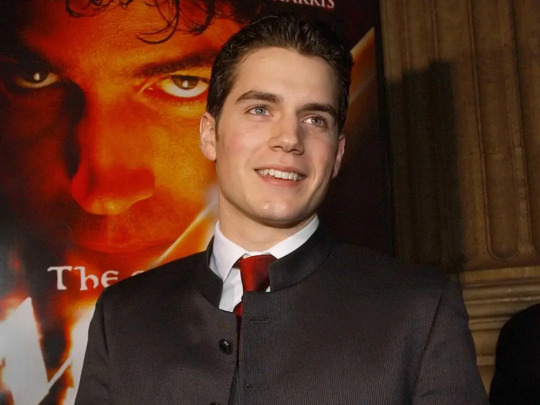
Cavill's acting career began in the early 2000s, when he landed small roles in television shows such as "The Inspector Lynley Mysteries" and "Midsomer Murders." He also appeared in the films "Laguna" and "The Count of Monte Cristo" in minor roles. However, it wasn't until 2007 that Cavill's big break came.
In 2007, Cavill was cast as Charles Brandon, 1st Duke of Suffolk, in the Showtime series "The Tudors." The show, which chronicled the life and reign of King Henry VIII, was a critical and commercial success, running for four seasons. Cavill's performance as Brandon was praised by critics, and it helped him gain recognition as an actor.
Rise To Fame
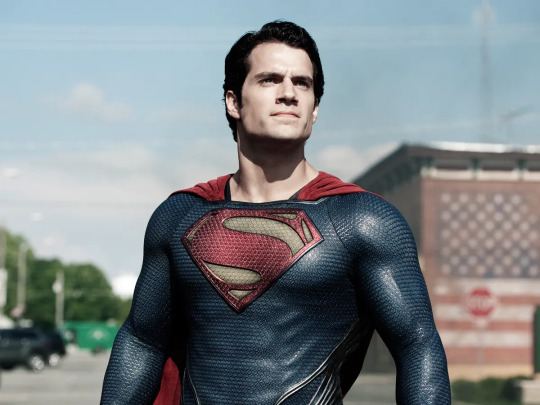
Despite his success on "The Tudors," Cavill's big break in Hollywood didn't come until 2011, when he was cast as the titular character in "Man of Steel." The film, which was directed by Zack Snyder, was a reboot of the Superman franchise, and it marked Cavill's first major role in a blockbuster movie.
Cavill's performance as Superman was widely praised by critics, with many calling him the best actor to ever play the iconic superhero. His portrayal of Superman was praised for its depth and nuance, as Cavill brought a sense of humanity and vulnerability to the character that had not been seen before.
Following the success of "Man of Steel," Cavill reprised his role as Superman in "Batman v Superman: Dawn of Justice" and "Justice League." He also starred in the spy thriller "The Man from U.N.C.L.E." and the action movie "Mission: Impossible – Fallout."
In recent years, Cavill has also made a name for himself on television, starring in the hit Netflix series "The Witcher." The show, which is based on a series of novels by Andrzej Sapkowski, has been a massive success, with Cavill's performance as the monster hunter Geralt of Rivia being praised by fans and critics alike.
Personal Life

Despite his fame, Cavill has managed to keep his personal life relatively private. He has been linked to a number of high-profile women over the years, including actress Kaley Cuoco.
#Henry Cavill#British actor#Man of Steel#Justice League#The Witcher#The Tudors#Superman#Hollywood#blockbuster#career#personal life#acting#Netflix#Geralt of Rivia#Charles Brandon#Batman v Superman#Zack Snyder#showtime#television#movies
5 notes
·
View notes
Note
if roman is gonna be exploring his sexuality w men in s4 do you think that means romangerri is dead for good 😭😭
i'm gonna start by saying it is so so way too early to speculate on full storylines in season 4 considering the writers just barely got back in the room and i'm guessing they don't have the full season figured out...but for funsies let's do it anyway lol
short answer: i don't think j is going anywhere and i think roman and gerri's stories and character development are too tied up in each other to suddenly go to nothing. there will be things in season 4 for them together and in regards to each other. that being said...no happy endings is the motto!
long answer about a couple things i think we could possibly see for roman and gerri in season 4 below the cut. and when i say long answer, i mean long answer lmao sorry!
first and foremost, i think they're gonna have to acknowledge the fracture that results from the way season 3 ended. they've had minor tiffs (shareholder meeting, dick pic convo), but i think it would be very sexy delicious for them to have a proper fight about it. kieran and j have both said something to the effect of "gerri wanted to help him, and roman knew she wanted to help him, but there was just nothing she could've done", so what is the outcome of that? i think even if roman knows gerri's intentions weren't to hurt him, he could very well be embarrassed/hurt by how it all went down, and we've seen that when he's embarrassed/hurt, he runs and/or shuts down. or, alternatively, he could confront her about it, they could argue, but it would be a moot point because, again, there's nothing she could've done. i think if they have a real argument about it, they hit an impasse and decide to put some distance between themselves slash take some time apart from their relationship/alliance/whatever you want to call it.
then there's the mencken of it all...
so in rewatching the roman/mencken exchange in 3x06, i think it makes sense that he may became a major player in roman's season four storyline. one of the things that stood out to me when it aired and again when rewatching was the way he does the "i wanted to talk to you about something" line that he does to gerri in 3x02. it's not the same kind of conversation and he's not really asking the same thing of mencken that he was asking of her, but the familiarity of the way he so easily finds himself conspiring with jeryd (sp?) from that point is obviously reminiscent of the way he is used to conspiring with gerri.
i also think the whole pick the president thing will come back big because, if we're following the show's timeline and caroline's wedding was in june, a theoretical "republican national convention", which they reference frequently in 3x06, would likely take place in august, and obvi election would be november. if they lean on needing the president's help to get the deal done, or to keep the regulatory antitrust stuff from stopping them, whatever, then yeah maybe the focal point (because for two and half seasons the focal point was the shareholder meeting lol) is the election.
it's also like...we're moving past the point where the titular succession is about succeeding logan. i think if they hone in on the politics of it all in season 4, it would be about "succession" in the sense of who will be next to succeed the role of president
all that to say MY idealized roman/gerri season long arc for season 4 would be that they have a little fight and take a little "break", roman gets in too deep with the politics/mencken of it all, becomes a little bit enamored with him, tries to fuck him and gets fucked over because of it. i think if something went disastrously with mencken, especially if it had to do with sex or something he was embarrassed/ashamed of, he wouldn't look to his siblings for advice, he'd come back to gerri looking for help. alternatively, maybe it looks like roman going down the politics rabbit hole and gerri, realizing that she does genuinely care about his wellbeing and seeing that he's going a little insane, tries to pull him back out of it.
and that's really more if it goes down the roman/mencken route! i think there's a case to be made that he goes in that same direction but with lukas – he's like i'll endear myself to the new boss because i've got good ideas and he likes me and instead of taking over for dad i'll just take this all over from him in a few years, things goes haywire, he comes back to gerri for help or gerri has to save damsel-in-distress roman
all of that also to say that doesn't factor in a lot of other show-wide things! like sibling stuff – i genuinely don't know what the writers have in mind for the three kids and the fallout of logan deciding to sell, which could also dramatically shift all of their storylines. what about logan and gerri's relationship in the wake of her sexting with his son? do we come back to that at all? where does tom's thing come into all of this? who knows!
#gerri kellman#roman roy#jeryd mencken#answered#anonymous#s4 speculation#this is...a big ol mess#and i'm sure i will come back to this in the future and be 100% wrong about most of this...but this is just where i'm at right now!
27 notes
·
View notes
Photo
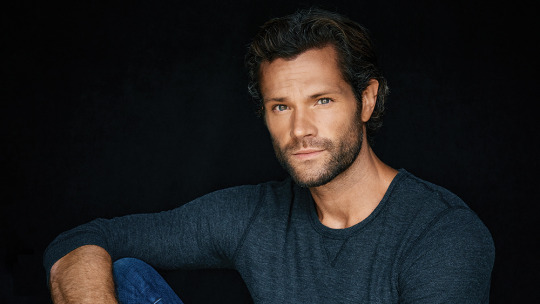
Jared Padalecki Talks Transitioning From ‘Supernatural’s’ Sam Winchester Into ‘Walker’
In the spring of 2019, while Jared Padalecki was finishing shooting what would become the penultimate season of “Supernatural,” he began to sketch out an idea for his next project. After starring in the WB Network/CW drama alongside Jensen Ackles since 2005, Padalecki’s first thought was of continuing their partnership beyond that one show.
“I was tired of being on camera for 20 years straight,” he says. “I wanted to produce a show called ‘Walker’ starring Jensen Ackles.”
“Walker” would be a reimagining of the enduring CBS series “Walker, Texas Ranger,” which ran for nine seasons between 1993 and 2001 and starred martial artist and actor Chuck Norris in the ass-kicking titular role. But unlike the new versions of vintage series that the CW has launched before, from “90210” to “Melrose Place,” “Walker” will not continue the world or any of the characters of the original show. Instead, the series follows the modern trend of updating its story and its hero for the present-day audience.
The idea came to Padalecki in his Vancouver trailer after reading an op-ed by a law enforcement official who walked away from duty rather than submit to separating migrant kids from their parents and putting them in cages, as was being asked of him. “I thought, ‘What an interesting person who struggles with what they are bound to do by duty and what they think they should do by their own moral compass,’” he explains.
From the beginning Padalecki knew he wanted his show to be about such an officer, and he knew he wanted to film in Austin, Texas, which is not only the headquarters of the Texas Rangers, but also where he and his family reside. It wasn’t until the extended producing team of Dan Lin, Lindsey Liberatore and showrunner Anna Fricke were in place that he realized he should star in it, too, because it was his “passion project.” Then “Walker” was truly born.
“The original [series] was this lawman who abides by his own rules, and he would just do head-spinning kicks on people, and obviously we can’t do that now; that would be laughably bad,” Padalecki says. “We don’t want the audience to ever know whether Walker is quote conservative or quote liberal, or quote Republican or quote Democrat. This version of ‘Walker,’ we play with the gray area: This is not a show about a martial artist kicking minorities in the face; this is a show about a legit Texan saying, ‘Hey, I need to hear the whole story before I make a decision.’ So this version is less about what goes through somebody’s fists and feet, and more about what goes through somebody’s head and heart.”
Padalecki’s character will therefore challenge some antiquated notions of what it takes to be tough. “I’m sure there are some MAGA hats who may be pissed off,” he notes, but he was “just in no way interested” in doing a show that leaned into toxically masculine tropes.
Even though CW chairman and CEO Mark Pedowitz acknowledges the show is “a different flavor” for the network, he wanted it on his schedule because of “a five-letter word,” namely, Jared. “Jared had a desire to do this; we had a desire to support Jared — it was a good mix,” Pedowitz says. “If we’re going to expand what the brand is, it’s good to expand with a person who has represented the brand so well through his career.”
After guest-starring roles in series such as “ER” and appearances in films from “Cheaper by the Dozen” to “New York Minute,” Padalecki saw his career kick-started when he booked the role of Rory’s boyfriend Dean on “Gilmore Girls,” which was airing on the WB network. He appeared on that show from 2000 to 2005 and then booked “Supernatural,” also originally for The WB. When the network was shut down and The CW was born, “Supernatural” survived and Padalecki went on to spend the majority of his career there. Now he is expanding his résumé and relationship with the network not only by being No. 1 on the ensemble call sheet for “Walker,” but also by serving as an executive producer for the first time in his career.
“I want [Jared] associated in some form with The CW, no matter how it goes. So if it went with this as he only wanted to be a producer, that would have been fine,” Pedowitz says.
For Padalecki, earning the privilege to help shepherd a show from inception to air — behind the scenes in addition to on-screen — has been a singular experience. “I can protect that original idea, but furthermore I get to try and make sure our cast and crew are treated correctly and that some of the habits that can happen on a TV show that end up hurting people don’t materialize,” he says.
Where in “Supernatural” Sam Winchester was the younger brother in a duo, at the start of Padalecki’s show Cordell Walker is a widowed father of two teenagers who moves his family back to his parents’ ranch. Both characters are in mourning at the outset, and both have to balance their sense of duty to “keep the world safe” with their desire to focus on family. Given those parallels, what especially aided Padalecki’s transition from Sam, whom he played for 15 years, to Walker was the time he spent getting to know his new character before donning his Stetson on set.
(It also helped that Fricke asked him to be “scruffier” than the clean-shaven Winchester, in order to age him up a little.)
The CW put “Walker” on its development slate in the fall of 2019, when filming was underway on the final season of “Supernatural.” The plan was to shoot a pilot in April, but when the pandemic hit, Pedowitz pivoted strategy quickly and ordered the show straight to series in January. “I think we would have wasted people’s time trying to do a pilot in COVID,” he says, adding that if a production is going to run the risk of shooting, the network should be prepared for a series greenlight.
With production shut down this past spring, Padalecki found himself with months to sit with the script for “Walker,” which was “more time than I’ve ever had to try and create or understand a character,” he says.
When it was safe to resume production, Padalecki returned to “Supernatural” first, in August. He was wrapped out of that series on Sept. 10, and five weeks later, he was back in the States and on set at “Walker.”
“I don’t really know what it’s like to get rid of a character necessarily, so what I tried to do was focus on the new character. In ‘Supernatural’ I’ve been afforded the opportunity to do this a couple of times: There was Gadreel Sam, Demon Sam, Lucifer Sam, and so I’ve been able to approach these other roles with the thought process that I wanted it to be interesting but not classic Sam, because I don’t think acting is just being who you’re comfortable being,” Padalecki says. Now, “Sam is just there somewhere in the background for me to visit him whenever I want, but Cordell Walker is who I’m helping to tell a story.”
The decade and a half that the actor spent on “Supernatural” has helped prepare him for “Walker” in other ways, too, from setting the tone as a leader on set to stunt work — although he admits there has been an adjustment from riding shotgun in a 1967 Chevy Impala when heading to cases to “chasing down perps” on horseback. On a personal level, being thousands of miles away from his kids while filming “Supernatural” has informed the emotions and struggles Walker experiences having to jet out of town for his job.
“I’ve been absent a lot,” Padalecki reflects. “When I’d get home to Austin, my kids [didn’t] understand that I’m not just skipping out, that I’m working really hard — 18-hour days — to try and pay the mortgage and buy their food and pay for their school and their uniforms and their toys. I didn’t know the routine. I’d get home and want to spend time with my kids, but they’re not used to me and I’m not used to them. It is very much art imitating life.”
In between takes on “Walker,” Padalecki wants to create a family vibe for his fellow cast and crew members, which is taking some figuring out since COVID-safe protocols limit interaction. When they call “Cut!” at the end of a long day of shooting, he gets to hop in his car and head home to his wife, Genevieve Padalecki (who will play Walker’s deceased wife, Emily, in the new show), and his three kids, Thomas, Austin and Odette. Now more than ever, he can be a part of setting that routine at work and at home.
“For so long I didn’t know what my life was outside of ‘Supernatural.’ I’m starting to figure it out now,” he says.
297 notes
·
View notes
Text
warning: this post is just me ranting about the writing of the naruto women for far too long
i honestly feel that one of the most frustrating/vaguely hilarious aspects of naruto is how naruto ended up being - and bear with me here - the best example of the extremely specific female archtype that kishimoto seemed to be obsessed with.
like when you focus on sakura and hinata - arguably the most important female characters in the show as the two male leads’ respective end game love interests - you can break them both down into the same general mold:
- both devoted to the same boy their entire lives
- both are shown chasing after their crush in order to stand on “equal” footing (i.e. sakura’s “i finally caught up to them” and hinata’s “no longer chasing but standing by your side” mentalities)
- both suffer and try to overcome feelings of inferiority in their respective character arcs
and i want to be clear that while female characters who fit this mold aren’t usually my favorite thing it can definitely still work when written carefully and written well - to be blunt i personally think both hinata and sakura are awesome character concepts and both had SO MUCH potential and i love their fanon interpretations but i feel that canonically they were poorly written, underdeveloped, and flat characters
most of their canonical character motivations revolve around their love interests - which really sucks because i would have KILLED for a deeper look at everything involving hinata and the hyuuga or even more about sakura’s development of her medical ninjustsu so much got skipped when it came to them which definitely didn’t help anything - that aside this is especially true in og naruto though to be fair - sasuke was still in konoha in og naruto and team seven was together for most episodes which made it especially prevalent in sakura’s case
the point is by the time shippuden came around it was extremely obvious that efforts were being made to improve the female characters - sakura now had much higher combat ability from the start of shippuden and, though she gets much less focus hinata is repeatedly shown doing brave acts and pushing herself to become stronger. and while i really loved the effort and it was definitely an improvement from especially sakura’s original character - it still fell flat to me.
sakura’s fight with sasori was perfect and a great way to revive her character but then she was pretty stagnant in a lot of the following arcs - i.e. injured in the reunion arc, not very important during the two saviors arc, her weird fake love confession during the assembly of the five kage arc, etc. - she constantly bounces between “now i’m strong” and “i still don’t measure up” making her character development - especially pre-war - virtually nonexistent because every step forward gets followed by a step back.
hinata is a bit more difficult simply because she’s such a minor character for so much of shippuden which is insane since she’s literally the protagonist’s future wife. regardless, looking at hinata’s big moments: her fight with neji in og naruto, blocking naruto from pain in shippuden, and the Smack during the war (there’s a few i’m missing i’m sure but those are really what constitutes her biggest moments to me during the meat of shippuden’s actual development phase - not the post war resolution phase) two of three of these moments precede her getting very heavily and soundly beaten which personally irks me - even if i don’t particularly like it i can see why and it makes sense to me she didn’t win the fight with neji or her pain confrontation and it definitely shows that she is brave and emphasizes the all-important devotion to her love interest aspect of her character BUT it’s also a little obnoxious that we never get to see her be REALLY victorious in her major moments.
so to sum up so far: sakura and hinata are both meant to be perceived as innovative and strong female characters but this perception doesn’t work in sakura’s case because she immediately repeatedly reverts back to the damsel in distress archtype and it doesn’t work in hinata’s case because the few strong moments she has are highlighted by failure.
and also the all important point that the majority of their “strong moments” are driven by their love interests - not a bad motivation except for the fact that that is one of their ONLY motivations
to the main point i’m trying to make: lets compare naruto (obviously take this with the understanding that naruto has a MAJOR advantage of having way more screen time and development as the titular character)
in regards to sasuke, naruto:
- is extremely devoted
- repeatedly chases after sasuke to match-up with him and improve
- and, especially in og, struggles with feeling inferior to sasuke
the context is a little different and the motivation behind some of the points changes between the two but it’s the exact same mold as sakura and hinata
the major difference between the two and the main reason that so many more people get frustrated with sakura’s devotion to sasuke and not naruto’s really boils down to development
sakura barely had her own character outside of loving sasuke and when she did, it immediately got downplayed in some way - just look at the war arc and her triumphant “i finally caught up to them” right before both sasuke and naruto essentially gain godlike powers, she then spends the war constantly distracted by sasuke even when fighting “sasuke isn’t worried about me at all” which really downplays her role.
on the flip side, even with his main goal of bringing sasuke back to the village, naruto has tons of motivation and character building outside of sasuke - ex. becoming hokage, gaining everyone’s acceptance, fixing konoha, living up to his parents/jiraiya’s expectations, bringing peace, protecting everyone he can, freeing the tailed beasts, etc. etc. you could go on forever the show is named after him after all.
we are told that sakura always chooses sasuke and nothing else about it but then we are told that naruto chooses sasuke despite everything else.
to sum up: the traditional female love interest that kishimoto wants to invent is the woman who is devoted. she puts the person she loves above everything else because she loves him. she’d do anything for that person even if it puts her at risk, etc. but at the end of the day there’s still the tired trait of still relying on the man in her life for certain things. and he doesn’t bother to expand characters like sakura and hinata beyond that. (great examples of characters who are almost completely separate from this mold are tsunade and temari - though one might argue about the way they were written designed to fit specific tropes for comedic moments - personally i think they manage to dodge that for the most part though)
with naruto and sasuke - naruto manages to fulfill every roll sakura is meant to in a much more elaborated and better way all without the curse of the female love interest that sakura and hinata bear. it’s hard to accept sakura and hinata’s “i’ll love you no matter what” when naruto is already actively outright doing that with sasuke. the roots of sakura’s feelings for sasuke, hinata’s feelings for naruto, and naruto’s feelings for sasuke are all exceptionally similar to one another which is what shoots kishimoto’s main romances in the foot - because it’s hard for them to measure up to the main “platonic brotherly” relationship he built between sasuke and naruto.
this post is obviously disregarding a lot of the Other really deep parts of sasuke and naruto’s relationship and some important points about the other women of naruto. also it’s important to think on the time period naruto and naruto shippuden were written in. we’re in a major incline period for improvement in how women are presented in fiction - just look at the difference of women between og and shippuden. obviously it doesn’t completely excuse anything but it’s a point to consider.
sorry for the rant and sorry if this is all really obvious to you or if it’s worded poorly, kinda just needed to word vomit my thoughts. i really like analyzing how women are represented in fiction and how the representations have developed over the years. i wrote a few essays about it for some of my courses and now i think about it all the time. obviously i’m not claiming this is how everyone should view these characters or anything i just had lots of my own thoughts about the entire situation and dynamics that i had to put SOMEWHERE. if you have any thoughts about it or points you wanna bring up feel free to do so i love fiction analysis a lot so i love hearing other people’s opinions
#naruto#naruto shippuden#naruto analysis#20 years old and doing naruto analysis in my spare time rip#long post#pls ignore my messy thought process i haven't been sleeping super well so i'm not sure about the clarity on this one tbh#also sorry i know this isn't like my usual posts was just in a Mood#if any of you like my awful takes let me know because i have tons of them i just never post any because the posts end up stupid long like so#anyone who read the whole thing im sorry are u okay?#my posts#also i know sometimes these posts can bother some people so let me know if i need to add any tags to help with that! i gladly will
42 notes
·
View notes
Text
(Accidental 150 Follower Special) IOTA’s Top 10 Best (and By That, I Mean Personal Favorite) Episodes of Miraculous Ladybug
Alright, I already covered what I considered to be the worst Miraculous Ladybug episodes in two parts, and now it’s time to talk about the what I consider to be the best Miraculous Ladybug episodes before I talk about... him...
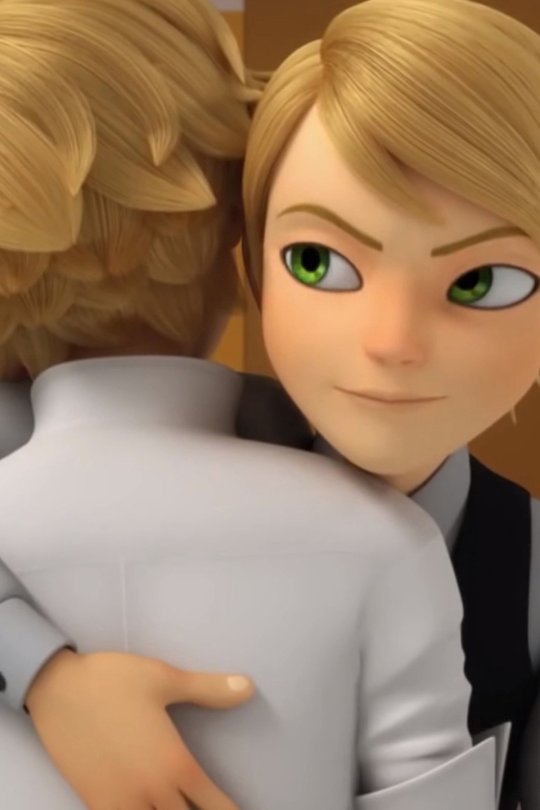
I’m only putting one rule in place for this list. I'm going to try and list episodes with good qualities other than “cool-looking Akuma and awesome fight scenes”, and focus on other details like character moments and story.
Other than that, let’s get started.
These are the Top 10 Best Episodes of Miraculous Ladybug (in my personal opinion because your opinion is also valid)
#10: Mr. Pigeon
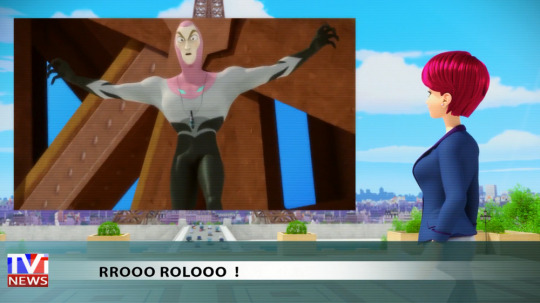
While Marinette works on sketching a design for a hat for a fashion contest where the winning design will be worn by Adrien (a rare example where the “Marinette does a thing to impress Adrien” plot actually works), a birdwatcher who loves feeding pigeons in the park is told off by the only police officer in Paris, causing him to get akumatized into the titular Mr. Pigeon, who has control over all of the pigeons in the city.
And by God, does this episode have fun with the concept.
In addition to constantly mimicking pigeon cries, Mr. Pigeon's movements are just so entertaining to watch, only aided by the creative ways he controls the flocks of pigeons.
I'm not kidding when at one point, Mr. Pigeon traps Ladybug and Cat Noir in a cage, and threatens to have his pigeons crap on them unless they hand over their Miraculous. Yeah.
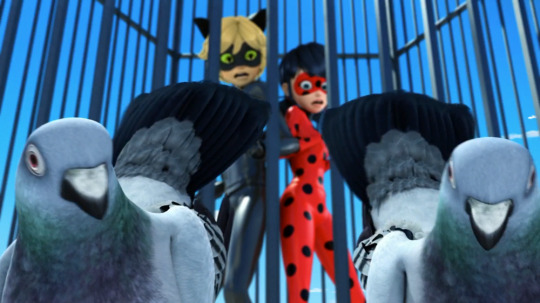
This is one of the episodes that really set the standards for how outlandish the Akumas in Miraculous Ladybug could get. It kind of reminds me of an episode of the original Ultraman, where the SSSP has to find a way to move an incredibly heavy monster using increasingly abnormal strategies, like inflating it with air so it'll float like a balloon. It's clear it isn't taking itself too seriously, so the audience shouldn't either.
Admittedly, Cat Noir's feather allergy feels shoehorned in, and is only included to increase conflict, and you would think it would come up when Mayura, a bird-themed supervillain appears in the third season. But then again, that's just a minor nitpick.
It's just a really fun episode, and I wish we could see Ladybug and Cat Noir fight Mr. Pigeon again that isn't used for a cheap gag.
#9: The Puppeteer
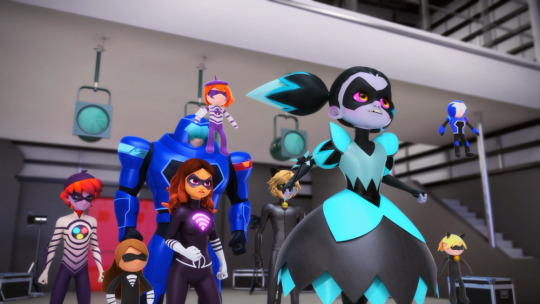
After being told by her mom that she can't have a Ladybug doll made by Marinette, young Manon is Akumatized into the Puppeteer. But obviously, you can't have our heroes beating up a five-year-old, so instead, the Puppeteer has the power to exact control over past Akuma victims as long as she has the doll made by Marinette. So Ladybug and Cat Noir have to face off against Lady Wifi, the Evillustrator, and Rogercop, before the Puppeteer gets her hands on the dolls Marinette made of the two heroes and take control of them as well.
It's still kind of funny to think about the fact that of all the Akumas to become a huge threat to Ladybug and Cat Noir, it's a little girl throwing a temper tantrum. And like with “Mr. Pigeon”, the episode has a lot of fun with the concept, best reflected in the voice acting. You can tell that Carrie Keranen is having so much fun this episode with the stuff she says as Lady Wifi.
The fact that someone who was actually a major threat to the heroes with how she was able to easily outsmart them and also came really close to getting their Miraculous is now acting like a little kid using phrases like “super duper sorry” is even more hilarious.
I'm still a little confused as why of all the past villains, it's Evillustrator and Rogercop that get to come back, and I wish they had gotten more to say, but it's still a treat to see Ladybug and Cat Noir fighting four villains at once, especially since this was before “Heroes Day”.
#8: Sapotis
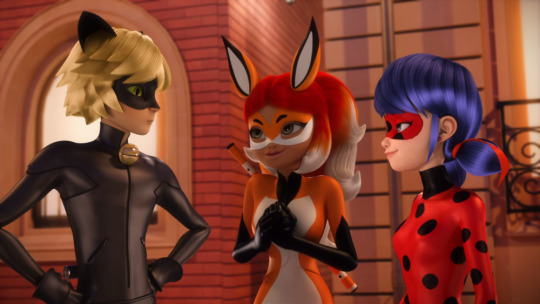
Hawkmoth akumatizes Alya's little sisters into Sapotis (supposedly based off a folktale, but I can't find anything about it online), who have the power to multiply and easily overwhelm Ladybug and Cat Noir, forcing Ladybug to recruit Alya to become a third hero, Rena Rouge.
I've been a little negative about Alya in the past, but this episode gives her some major character growth. One of the biggest problems I had with her character in Season 1 is how often she tried to figure out Ladybug's identity... despite claiming to be a huge superhero fan, who should know why superheroes keep their identities a secret. Thankfully, this episode mostly puts an end to this idea.
The episode opens with Marinette giving Alya some reasons why Ladybug would keep her identity a secret, and it actually plays into the episode.
Putting aside the stupid Rent-A-Miraculous system introduced in this episode, the idea of keeping secrets and how necessary they can be sometimes is reflected after the battle where Alya is hesitant at first to give up her Miraculous, but eventually concedes and keeps her identity a secret from Marinette (who ironically knows, but that's not important).
Even without that, this episode still has a lot of action with the three heroes fighting their way through an army of Sapotis, with plenty of banter during said action. Hell, at one point, Cat Noir says “gotta catch 'em all”. I don't have a joke here, that's just brilliant.
Out of all the introductory hero episodes, this one easily sticks out among most of them.
(Don’t worry, I’m going to talk about Rena Rouge’s character design in a later post.)
#7: Guitar Villain
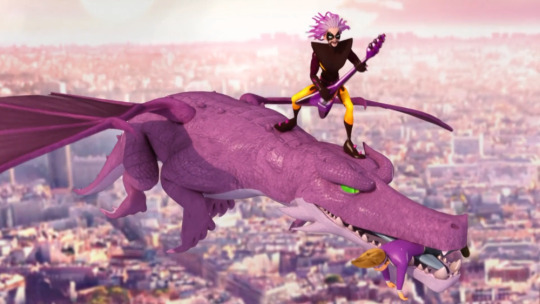
I said before in an earlier post that Jagged Stone is one of my favorite characters in Miraculous Ladybug, so it's obvious that the episode where he gets akumatized would be on this list.
After a disagreement with his manager about trying to mimic the popular singer XY (who ironically lacks a Y chromosome), Jagged is akumatized into Guitar Villain, a rock star with a pet dragon who forces everyone to listen to his Awesome Solo (yes, he names his attacks too) to dance uncontrollably.
Honestly, there's not much I can really say about this episode. It's Ladybug and Cat Noir fighting a rock star who flies around on a goddamn dragon. That's one of the coolest things I've ever seen! Even the way they defeat him (which I won’t give away) is a fun jab at rock stars.
Admittedly, the episode does border on grouchy old man territory sometimes by complaining about how bad today's music is with the way they portray XY as a whiny and egotistical coward, but after watching “Silencer”, you'll be glad everyone hates him.
Overall, it's a rockingly awesome episode.
#6: The Dark Owl
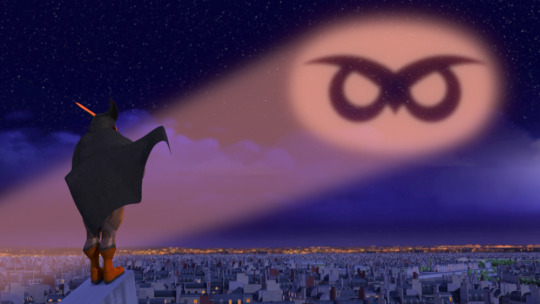
Mr. Damocles, the principal of Marinette and Adrien's school, is akumatized into the Dark Owl, a corrupted version of his favorite comic book superhero (who would later turn out to be real in the New York special, but I don't want to acknowledge that), who uses his high-tech gadgets to trap Ladybug and Cat Noir, putting them in one of their toughest binds yet.
I'm a huge fan of the Adam West Batman show, so you could probably guess why it's on this list. This episode really feels like an episode of that show with how goofy and over the top everything is. Obviously, this episode has a few Batman references thrown in (even an Incredibles reference at one point), and they're all hilarious.
I just love how complex Dark Owl's traps for Ladybug and Cat Noir are, and the fact that he actually manages to outsmart them at one point. Like seriously, have you ever heard of a death trap that involves drowning someone in whipped cream? That’s totally something you’d see the Joker setting up.
I don't really want to give away the ending (which is why this part is so short), because I think it's a really clever resolution that you should check out for yourself.
#5: Gorizilla
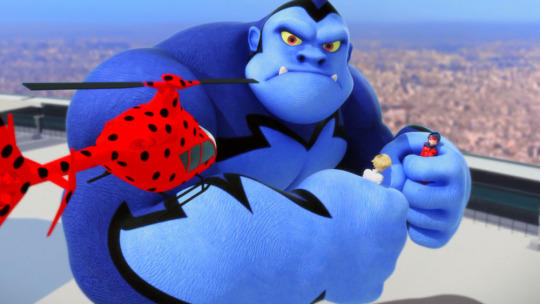
Hawkmoth akumatizes Adrien's bodyguard into Gorizilla, whose sole purpose is to protect Adrien. His motivation? To see if Adrien is actually Cat Noir or not. So Adrien has to avoid this gigantic gorilla's wrath with Marinette, all while trying to catch a movie his late mother was in.
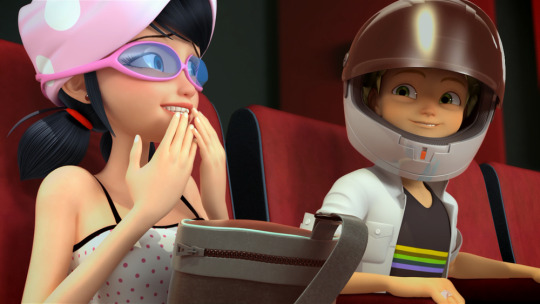
See this? This is Adrienette done right. This is the kind of interaction I like when it comes to romance. Marinette and Adrien spend a few scenes with each other avoiding Adrien's crazy fanbase, and Marinette doesn't stammer half of her words. Even when she interacts with Adrien as Ladybug, she still remains confident, and Adrien trusts her judgment when it looks like he might fall. I don't just want Marinette and Adrien to cuddle with each other or declare their love for each other when they get their memories wiped. I want them to interact like human beings before they actually start a relationship, and this episode is a good example of it.
Adrien also gets some good focus with the way he views his relationship with his parents, as does Gabriel with his relationship with his son. Granted, he's taking a pretty huge gamble trying to kill Adrien to see if he's Cat Noir or not as opposed to just... taking off his ring while he sleeps. Can we at least admit he's trying?
I feel they could have done more with the King Kong homage (guess who I'm talking about?), but I can understand there wasn't enough time to focus on that. It's still an important episode to watch for plot and character growth that will barely be acknowledged in later episodes.
#4: Sandboy

tHe SaNdBoY hAs ChEcKeD iN. nOw NiGhTmArEs CaN bEgIn.
Now that we got that obvious joke out of the way, let's talk about one of the most creative episodes of the show.
Tikki and Plagg, Marinette and Adrien's Kwamis (the magical beings that power their Miraculous) take part in a ritual with the other Kwamis inside Master Fu's Miracle Box to contact Nooroo, Hawkmoth's Kwami, on his birthday and get an idea of where he is. Unfortunately, Hawkmoth chooses to akumatize someone during the ritual, leaving Marinette and Adrien helpless to fight back against Sandboy, an Akuma with the power to make their worst fears come true.
I said before in my worst list when talking about “Ladybug” that there was too much going on for one episode, what with Marinette's expulsion, the attempted Scarletmoth attack, and the fake Ladybug plotlines generally being rushed through. This episode is basically the opposite of that (ironically, they're both the penultimate episodes of their respective seasons).
The Kwami ritual and the Akuma attack are perfectly staged together so one affects the other. Not only do the Kwamis have to risk aborting their ritual to reach Nooroo in order to fight the Akuma, but Marinette and Adrien have to deal without fighting off Sandboy's nightmares on their own. Both plots balance each other out into a well-crafted story.
This is also one of the only episodes in the show where the Akuma of the week isn't the man focus. Here, we don't even see what happens to get the kid akumatized into Sandboy, and instead, Gabriel senses someone with negative emotions and akumatizes the kid offscreen. This works, because it doesn't distract from the main plot too much.
Even Marinette and Adrien's worst fears beautifully contrast each other, with both managing to be unsettling in different ways, even if they both have different tones. While Adrien's worst fear is being imprisoned in his own room (the fear only made worse with Plagg's absence), Marinette's worst fear is... the real star of the episode. Ladies and Gentlemen, I think you all know who I'm talking about.
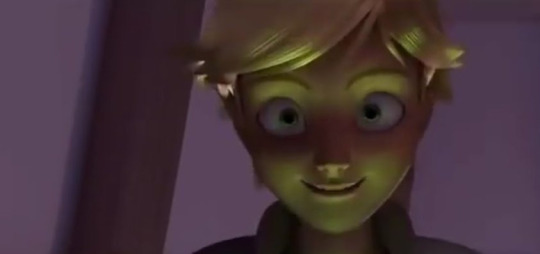
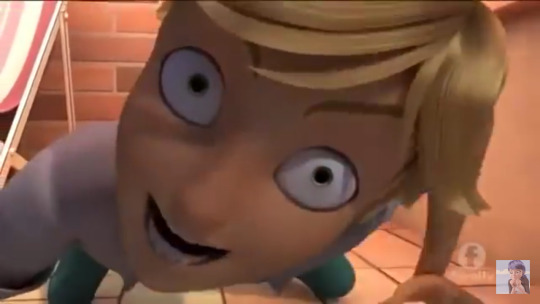
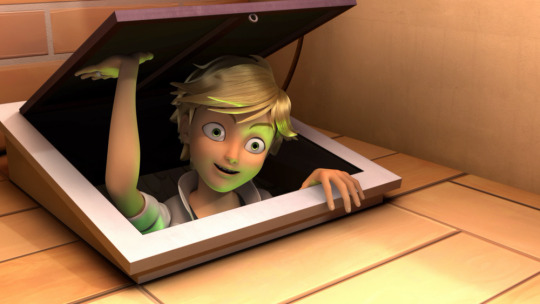
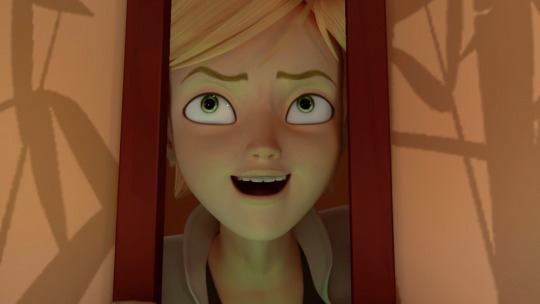
You can tell the animators had a field day with animating Nightmare Adrien. Just look at the way he moves around and the faces he makes. It manages to be terrifying and hilarious at the same time. Bryce Papenbrook's performance only makes it better, cementing this as the highlight of the episode.
This episode also does a good job at foreshadowing the main plot for Season 3 with Hawkmoth finding out about the other Kwamis and by extension, more Miraculous.
It's got plot, comedy, good action, and Nightmare Adrien, so how can you turn this episode down?
And no, I'm not talking about Nightmare Ladybug, mainly because I'm tired of all the evil doppelgangers from the worst list.
#3: Startrain
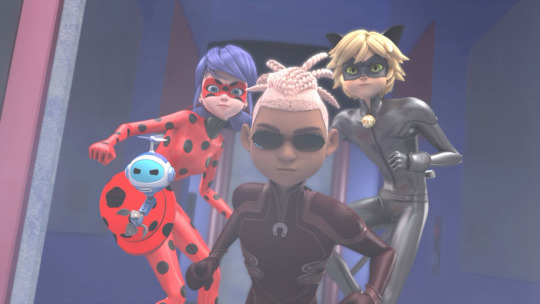
Yes, believe it or not, I managed to find a Season 3 episode that wasn't complete garbage, and spoiler alert, this isn't the only one.
Marinette and Adrien's class goes on a field trip to London by taking the train, until the driver is akumatized into Startrain, who wants to escape to the one place that hasn't been corrupted by capitalism... SPACE! So Ladybug and Cat Noir have to defeat Startrain while also finding a way to bring everyone on the train back home.
I like how this episode plays with the usual Akuma of the week formula. Unlike every other Akuma they've fought, Cat Noir points out that if they beat Startrain, everyone will die, so they have to be more strategic in their approach. They don't even fight Startrain for most of the episode, as they have to make their way to the front of the train to confront the Akuma. The action in this episode is very creative and really takes advantage of zero gravity, only aided by the design of the futuristic train the episode takes place in.
The new hero introduced, Pegasus (AKA Max, another student in Marinette and Adrien's class), is also really cool, being very intelligent and helping out the heroes progress through the train even before he gets the Horse Miraculous. It makes sense that his intelligence would be used rather than just his powers in this situation.
There are even some good character moments too. For once, Master Fu does something smart and loans the Horse Miraculous (which has the power of teleportation) to Marinette so she can still go on the class trip, trusting her and actually letting her have a life. It was also nice to see Alya stick up for Marinette by keeping Lila from interrupting her nap with Adrien.
This episode is basically like a refreshing glass of water to enjoy during the garbage fire that was Season 3.
(I’m going to talk about Pegasus’ character design later on too, don’t worry)
#2: Silencer
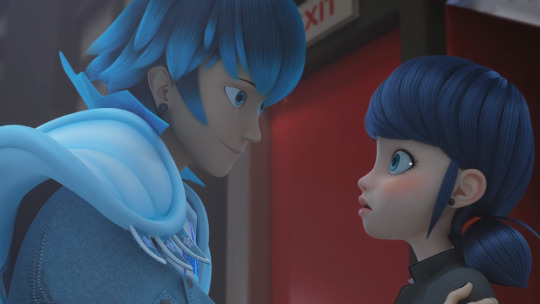
Lukanette shippers, ASSEMBLE!
Music producer Bob Roth and his son XY hold a contest for young artists to show off their skills, and Kitty Section, a band composed of several recurring characters, decides to enter, with Marinette helping to design their costumes. But as soon as they submit their video, they find out that XY copied their style, naturally pissing the band off.
Marinette and the lead guitarist of Kitty Section, Luka, confront Bob Roth and XY, who threaten to ruin their careers by claiming that they ripped off XY. Seeing Marinette getting threatened is more than enough for Hawkmoth to akumatize Luka into Silencer, who naturally has the power to silence and mimic the voices of others.
I talked about Luka and his relationship with Marinette in an earlier post (specifically the one where Astruc claimed that the fandom growing to like Luka counted as character development), and I said that this was one of the few good episodes this season because of their interactions. This episode basically made me realize how much Luka cares for Marinette, and the episode gives plenty of time to show the two spending time together and growing closer. It's basically everything ��Oni-Chan” should have been about, giving some depth to Luka and not portraying him as a crazy person like they did with Kagami in that episode.
Silencer is also one of the more creatively designed villains this season, and has a really creative approach to achieving his goals. While the ability to steal and imitate someone's voice seems mundane compared to control over the weather, or making nightmares come to life, it's used very effectively. Silencer basically tricks the police into arresting Bob Roth while imitating the mayor's voice, and he threatens to make his life a living hell by using the connections to the voices he's stolen. Even with the hand puppet gesture, it's still unsettling to have Silencer speak in all these voices, and it would make for a really interesting horror movie.
Even Ladybug and Cat Noir's interactions are back to their Season 1 levels of enjoyment. Even though Silencer took her voice, Ladybug just makes so many expressions that do a great job at describing her feelings, which naturally plays off Cat Noir's motormouth tendencies. Whenever Cat Noir jokes about Ladybug's condition, he is rightfully called out on it and is reprimanded in some way, my favorite being when Ladybug uses her yo-yo to hit Cat Noir on the head to shut him up. Even putting aside that, they still work well together this episode and really feel like equals. I also love their silent fist bump when Bob Roth is exposed.
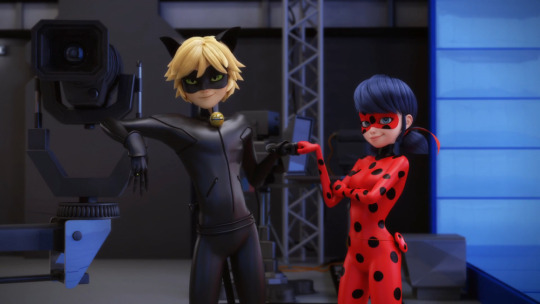
Again, the episode still takes the time to go on about how unoriginal today's musicians are, and how they lack artistic creativity and all that crap. Look, given how ham-fisted the writing in this show can get, are you surprised the commentary isn't subtle?
Even putting aside how much this episode made me appreciate Lukanette, it still has a lot of great moments that aren't even related to the ship itself, which is a real testament to how this show can perfectly balance romance and story when it's done right. Now if only the show could try this much with Adrienette, then people wouldn't hate the main pairing of the show this much.
#1: The Collector
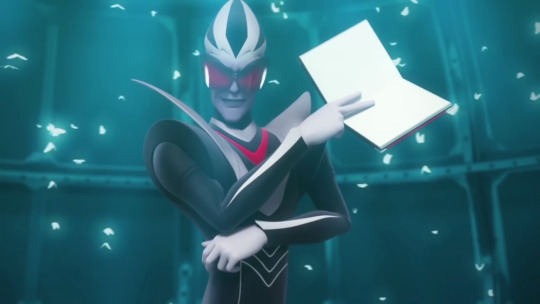
Taking place immediately after the Season 1 finale, Marinette meets Master Fu and discusses the book she found depicting past Miraculous users. Marinette theorizes that since the book was in the Agreste mansion, Gabriel could be Hawkmoth. And to the surprise of absolutely no one, she's right, and in order to draw off suspicion, Gabriel akumatizes himself into the Collector.
This episode has several good writing decisions for both sides, and the choices the characters make feel natural. Gabriel akumatizing himself is such a smart move, and so is what Marinette and Master Fu do with the book at the end. This episode does a great job setting up future plot threads and establishes Master Fu's character and the mystery associated with him.
The Collector is a visually stunning villain, and his powers are really creative, leading to a great fight with Ladybug and Cat Noir, who use a great strategy to outsmart him. I also love how over the top he is in order to make the heroes believe that he's working for Hawkmoth, all with a devious smile on his face.
This was also the episode that really got me into Miraculous Ladybug as a whole. I checked out the first season on a whim after it was mentioned in a Pan Pizza video, but it was during the hiatus between seasons, and I hadn't really started using Tumblr yet, so it mostly stayed off my radar. When Season 2 started however, I really got invested in the story, and the way this episode turned out was a big reason why. I wondered what it would be like when Adrien finds out his own father is Hawkmoth, and how the story would play out after the reveal.
Despite what it led up to, I still consider “The Collector” to be my favorite episode of Miraculous Ladybug.
Well, now that I talked about that, not it's time to talk about what I consider to be the worst episode of Miraculous Ladybug, “Felix”. God help me...
#immaturity of thomas astruc#miraculous ladybug#miraculous ladybug sugar#marinette dupain cheng#ladybug#adrien agreste#cat noir#chat noir#alya cesaire#rena rouge#max kante#pegasus#gabriel agreste#hawk moth#hawkmoth#xavier ramier#manon chamack#jagged stone#xy#bob roth#principal damocles#mr damocles#nightmare adrien#luka couffaine#master fu#thomas astruc
112 notes
·
View notes
Video
youtube
This week on Great Albums, we look at a surprisingly experimental album from a band who got royally screwed by their record label: Propaganda, with their arguable only LP, A Secret Wish. Oh, and did I mention that that record label was none other than Zang Tuum Tumb, run by none other than Trevor Horn? Find out the whole story in the video, or in the transcript below the break.
Welcome to Passionate Reply, and welcome to Great Albums! In this installment, I’ll be looking at a relative sleeper of its era, with a unique sound that’s set it apart and won it a contingent of cult followers over the years: A Secret Wish, the first, and only, studio album from the classic lineup of Propaganda, first released in 1985.
First formed in Duesseldorf, West Germany by Ralf Doerper of Die Krupps, Propaganda soon relocated to Great Britain in the hopes of finding a wider audience for their music. Their lucky break came in the form of being signed to the record label Zang Tumb Tuum, headed by then-rising star, Trevor Horn. Fresh off his first major success as a producer, ABC’s The Lexicon of Love, Horn then lent his famous production chops to Propaganda’s first single, “Dr. Mabuse.”
Music: “Dr. Mabuse”
The first time I heard “Dr. Mabuse,” I wasn’t familiar with the titular character, and that might be true for you, too, if you’re from the Anglosphere like me. Dr. Mabuse was a literary villain invented by Norbert Jacques, and later made much more famous in a film adaptation of his tale directed by Fritz Lang, the mastermind behind Metropolis. A manipulative criminal kingpin, Mabuse wields strange powers like psychic possession and astral projection, which, despite their seemingly occult origins, often exploit modern technologies, like cinema screens that can hypnotize people. While he may sound like the perfect subject for a chilling, brooding synth-pop anthem, I can’t help but wonder if the character’s relative lack of recognition in the English-speaking world may have hampered this single’s success. While its ominous, gothic energy sets it apart from much of Horn’s other work, it still has some of his characteristic bombast behind its sinister hook, and has an evident “hit single” feel. Still, it performed significantly better in Continental Europe than elsewhere.
Much like ABC’s famous hit, “The Look of Love,” was expanded into a four-part suite that included an instrumental reprise on its LP, this version of “Dr. Mabuse” is listed on the album with the subtitle “First Life,” and assorted variants of it were available in different formats. It also received an arguable reprise with the album’s final track, titled “Strength to Dream / The Last Word.” The title is a bit more opaque than that of “The Look of Love (Part Four),” which made the relationship more obvious, but the synth sequences do bear a rather strong resemblance.
Music: “Strength to Dream / The Last Word”
Unfortunately for Propaganda, Trevor Horn quickly became a little too successful for his own good. Labelmates Frankie Goes to Hollywood achieved unprecedented success with Welcome to the Pleasuredome, and their famous singles “Relax” and “Two Tribes,” which led Zang Tumb Tuum to throw almost all of their promotional support behind their newfound golden child. The release of A Secret Wish was postponed, and Horn was no longer able to produce the rest of the album, besides “Dr. Mabuse.” But despite the fact that Horn isn’t actually here, there’s still a noticeable attempt to finish the album in an aesthetically similar, “in-the-style-of” fashion, and the end result is an LP that's surprisingly quite sonically cohesive!
Music: “Jewel”
With its abrasive textures, aggressive energy, and heavy emphasis on percussion, “Jewel” feels more like a track from the Art of Noise than it does Horn’s triumphant pop productions like “Relax.” “Jewel” also has an alter ego on the same album, and serves as a sort of evil doppelgaenger for the similarly-titled track, “Duel.” The two tracks feature the same lyrics, but vastly different treatments and moods.
Music: “Duel”
I like to think “Jewel” displays how a tumultuous relationship looks from outside, painful and unpredictable, whereas “Duel” is a bit like experiencing it yourself, and being so enraptured by the blissful pain that you don’t realize how frightening the lyrics actually are. Besides the much softer instrumentals, the lead vocal performance by Claudia Bruecken is also markedly different, and I think the contrast between the two is a testament to her vocal chops. Throughout the album, Bruecken’s voice is rich and full of character, setting her apart as one of the more distinctive vocalists in 80s synth-pop.
Overall, “Duel” is perhaps the most accessible and easy to like track on A Secret Wish, and it accordingly became the album’s biggest hit. But unlike most obvious singles, it arrives at the tail end of the album’s first side, after a slew of much more experimental tracks. Not only does “Jewel” arrive before “Duel” does, but the album’s opening track, “Dream Within a Dream,” is an eight-minute psychedelic opus based around a text by Edgar Allen Poe! “Duel” feels a bit like a break for refreshments after listening to the earlier parts of the album. It really is a surprisingly experimental work given its relative commercial success, reaching #16 on the UK albums chart. Still, despite that success, *A Secret Wish* doesn’t seem too strongly remembered today, which is something I’d certainly like to see change. Counterbalanced between pop and the avant-garde, this album sounds like a cross between the Eurythmics and Einstuerzende Neubauten--something I say with as much affection as possible!
At first glance, the cover of A Secret Wish almost appears abstract, an inky web of squiggles. But upon closer inspection, one can see that the object depicted on the cover is actually a dress form, a wireframe in the shape of a human torso, which might be used to display clothing in a retail setting, or in the design of clothing.
While this emblem may not sound particularly sinister, I’m tempted to compare it to Harry Harlow’s famous experiments on rhesus monkeys. Harlow took orphaned baby monkeys and offered them a “cloth mother” and a “wire mother.” Artificial effigies of monkey mothers dispensed food for the test subjects--one with a soft and cuddly body of cloth, and one with a cold and barren armature of wire. When distressed, Harlow’s monkeys sought shelter and comfort from the cloth mothers, regardless of which mother had dispensed food to them, suggesting that the comfort of their soft touch had a value of its own to the monkeys. The results of this research have often been used to suggest the importance of physical contact between children and their caregivers. Propaganda’s use of the cold, bare, female-coded wire frame, enshrined, alone, in the center of a drab-coloured composition, centers the idea of the inhospitable and the unloving. Perhaps it is a symbol of the inhumanity and alienation of modern life?
As I hinted at earlier, A Secret Wish ended up being the only album this version of Propaganda managed to put together, despite the tremendous promise that it shows. Feeling flagrantly under-compensated per the terms of their contract with Zang Tumb Tuum, the members of the band went to court, and eventually jumped ship to Virgin Records instead. That is, except for Claudia Bruecken, who decided to stick with Zang Tumb Tuum for several more years. Later in the 80s, she would team up with Thomas Leer to form the synth-pop duo Act, whose lone LP, Laughter, Tears, & Rage, is a worthwhile listen that I would consider the ideal follow-up to A Secret Wish--though it’s markedly less experimental and percussion-driven, sounding more like late 80s, post-Pet Shop Boys, baroque synth-pop.
Music: “Absolutely Immune”
My personal favourite track on A Secret Wish is the album’s final single, “p:Machinery.” With pounding percussion and buzzing synths, not to mention some dramatic and dystopian lyrics, this is definitely the track on the album that reminds me of Ralf Doerper’s industrial music roots! Apparently, parts of this track’s melody were composed by none other than Japan’s David Sylvian, who receives a minor thank-you in its liner notes. While I don’t think the finished track sounds terribly similar to anything of Sylvian’s, I can’t say I don’t find that pretty interesting. That’s everything for today--thanks for listening!
Music: “p:Machinery”
#music#album review#album reviews#great albums#propaganda#trevor horn#ztt records#claudia brucken#claudia bruecken#synth pop#synthpop#synth-pop
10 notes
·
View notes
Text
you can go 900ft in one round in pathfinder 2nd edition now: a comprehensive(ish) guide
disclaimer: this post is actually incorrect in a few ways now, but i'm just gonna keep it up reguardless for now because i still love the image of a raging deer going as fast as a racecar
i think like 4 or 5 ppl who follow me will care about this, but i just have to share it.
okay so what will we need to Go This Fast? in terms of rulebooks, actually very very litte. the Core Rulebook and newly released Lost Omens Ancestery Guide are all we need to make the fastest creature alive.
as an additional aside, we kinda have to understand how bonuses/penalties work in pf2e. if you know, just skip this section
there's 3 different types of bonuses you can benifit from: circumstance, item, and status. where they usually come from isn't important to understand, but you can read this section of the rules if you really want to know. essentially, there's only really 3 ways we can benifit from these bonuses, as only the highest of each type applies. we can have a look at armour class to see how this works particularly well:
Seelah is a lvl 8 champion, wearing +1 full-plate and wielding a shield. she is expert in heavy armour, as such her proficiency bonus is 12. full-plate has a +6 item bonus to ac, however because of the +1 potency rune, that increases to +7. Seelah currently has an ac of 29 (10+19).
raising a shield grants a +2 circumstance bonus to ac. Lem a bard, casts inspire defence, granting Seelah a +1 status bonus to ac. Seelah now has an ac of 32.
now that we got that out of the way, it's build time. i'll explain the reasons for picking up certain interesting things individually
Someone to cast Haste on you
i mean, duh. an extra action to Stride is always sexy.
Class: Monk/Swashbuckler
as you might know, monks have this tendency in ttrpgs to just go fast for no reason, and in pf2e they are no different. At lvl 3, Monks gain Incredible Movement, which grants a 10ft status bonus to speed, which increases by 5ft every 4 levels, up to a maximum of a +30ft status bonus. Swashbuckers have a similar ability with similar scaling, however it is only active at full force if they have Panache. for the sake of simplicity, i will just be using Monks.
Ancestery: Elf Beastkin
Ancestery/General Feats: Nimble Elf, Fleet, Animal Swiftness
"what's so special about these feats" you might ask. i shall answer: they give an untyped bonus to speed. untyped bonuses are FUCKING HUGE. it literally lets us ignore the only 3 types of bonus/penalty clause, and lets us stack some speed easily. Nimble Elf and Fleet give a +5ft bonus individually, however Animal Swiftness is a bit different. essentially, we can either gain a +5ft bonus and your choice of a Climb, Swim, or Fly speed, or a +10ft bonus. naturally for this dumb hypothetical, we want the +10ft bonus, but this feat is what basically started this endeavour.
Class Feats: Barbarian Archetype & Druid Archetype, Advanced Fury; Furious Sprint, Basic Wilding; Wild Shape
finally, the things that actually let us go very fucking fast. Barb & Druid archetypes are prerequisites, we need to take them for Advanced Fury and Basic Wilding. Basic Fury is also a prerequisite for Advanced Fury, but we aren't tight on class feats, so you can take it whenever after taking Barbarian Dedication, but before level 20. reason being, Advanced Fury grants us a level 10 feat, Furious Sprint at level 20. what does Furious Sprint do? well, with 2 actions it allows us to Stride up to 5 times our speed, or up to Eight Times Our Speed with 3 actions. we want this ability.
however, the ace up our sleeve, the coup de grace of this loadout, the glue that ties this all together, is Deer.
yes, you read that right, fucking Deer.
Wild Shape is a sexy feat, basically giving u infinite casts of certain battle form spells as long as you have time to refocus. what we'll be using is the Heightened 2nd ability of Wild Shape, which allows us to transform into the forms listed in Animal Form. if you would like, you can read the spell for yourself and figure out why this is so important.
i'll give u a moment
did u find it?

your eyes are not deciving you. the deer form of Animal Form has a base move speed of 50ft.
let's fucking finish this dumb math equation now
Base Speed: 50ft (Animal Form: DEER)
Nimble Elf: +5ft (untyped)
Fleet: +5ft (untyped)
Animal Swiftness: +10ft (untyped)
Monk's Incredible Movement: +30ft (status)
this angry monk deer has a grand total of 100ft of movement!
now, we can finally Go Fast
Wild Shape into Deer
Have someone cast Haste on you
Get Angry (rage)
3 action Furious Sprint, going 800ft using only 3 actions
Stride again for 100ft bitch, ur quickened
We have just gone 900ft in 6 seconds.
That's 150 ft/s
or 102.273 mph
or 45.72 m/s
or 164.592 km/h
or 13.333..% the speed of sound.
about as fast as the fastest fast ball ever thrown in baseball (105.8 mph, 170.269 km/h)
that's 374% faster than Usain Bolt's top speed (27.33 mph, 43.99 km/h)
q & a
why did u do this?
i don't know. i also did how many archetypes you could fit into a character w/o variant rules at one point and it was just as weird.
why isn't item bonus used?
short story: Polymorph trait states the only bonuses that can change the statistics you gain are circumstance and status. longer story: originally, i was going to use elf's base movespeed of 30ft, because that was the ancestery i knew was fastest, so i searched for item & circumstance bonuses that would help us. i discovered Greater Boots of Bounding grants a flat +10ft item bonus to speed, excellent. however, then my seach for speed fell a bit flat. that is, until i asked a pf2e discord i was in for help, and they pointed out that Wild Shape could perhaps make us go very fast. that's where the Deer wild card came in (thanks ink on the discord btw <3). comparing the two, elf + greater boots of bounding gives us 40ft before the other feats, and deer form gives us 50ft before other feats. losing the 10ft item bonus is pretty worth it given that we also just gain another 10ft.
how can we go faster?
the one type of bonus i have still yet to mention, the titular circumstance bonus. there's a major and minor problem. the major problem: most circumstance bonuses to speed specifically target your overland travel speed, not good ol' stride speed. as such, they're basically useless unless you wanna go 11 miles per hour overland if you also take Form Control. while this is definitely an amazing constant speed, this doesn't exactly help with the fastest we can go. so we move on to the sadder minor problem: there is one (1) other way we can get circumstance bonus to speed: Tiller's Drive. while it looks good, unfortunately the way that Bellflower Dedication works is that you would have to stay within 60ft of the character with the archetype to gain the effects. as you would need about 16 characters with the archtype, each 60ft away in a straight line, i didn't include it in the calculation because it would've been really weird and confusing to explain. so currently, there is no good way to gain a circumstance bonus to speed, but if someone finds it we will be able to go Just A Bit Faster.
#pathfinder 2e#pathfinder#pf2e#rpg#ttrpg#table top#post-it note#i've been writing this post since like 4 in the morning#and now it's 8#i haven't slept#i've only been thinking about fast#lost omens ancestry guide#has just opened the floodgates#again#paizo#u sick sons of bitches#another thing i wanna do#is maximum damage in one attack#which is also in this book#i just need to sleep rn#maybe in a week i'll post the math on that rkshssjsj#long post
46 notes
·
View notes
Note
You might've answered this already and I just didn't find it, but one thing that always perplexed me about Duke was how old he was in comparison to the other Batkids. It's obvious he's younger than Dick and Babs, and I pretty sure he's younger than Jason and Cass, and older than Damian, but I cannot tell if he's meant to be Tim and Steph's ages, younger, or older. Could you help me?
You’re all kinds of good here, anon!!! I answered a similar ask abt the Order of Adoption but didn’t dive into specific ages on that post BECAUSE well they didn’t ask lmaooo but ALSO:
Comic ages are very fluid usually! While Years™️ might pass in the canon proper, or while time seems to slow to a crawl, having a character’s age outright stated is something that occurs very rarely for most characters, if at all!
Because it’s always much easier to have a floating age range to work and play around in! It’s easier to keep a character Perpetually 12 or 16 or 25 or mid-40s or- you get the idea. SO, with that in mind. Let’s do our Best to Break Down What Age Duke Might Be Currently A N D how it might interact with the Other Batkids!
(Warning for a Very Long Post, lots of issue citations, and a LOT of comics terminology regarding specific runs/events/continunity. I’m gonna try to keep it as clear/concise as possible ofc but plz keep these things in mind! If you’re not at least marginally familiar with Bat-Comics, you might find yourself feeling a little lost here!)
So from the Zero Year arc we see a common Trend that plays out pretty consistently with Batfam comics: a Life-Changing Event Occuring while the protag is Young™️.
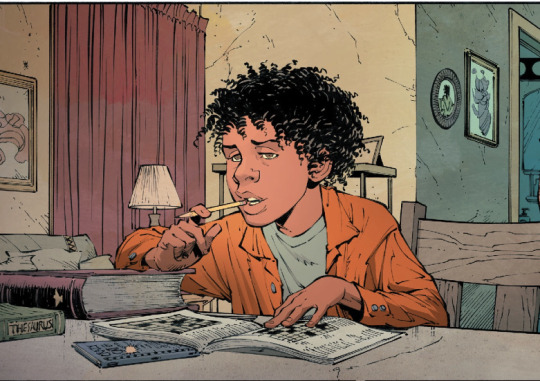
(Batman (2011) #30)
With how Duke is drawn in these particular issues, and given the trends of the past, I’d place him in the 8-12 range. The historic precedent being ofc that that is the same range that canon usually places both Bruce and Dick at for their Tragedies™; the more benign reason being that he... just very much Looks to be drawn in that Range. He’s very clearly an Older/Prepubescent child here.
Fast Forward to his Next Appearance in the Endgame arc and-
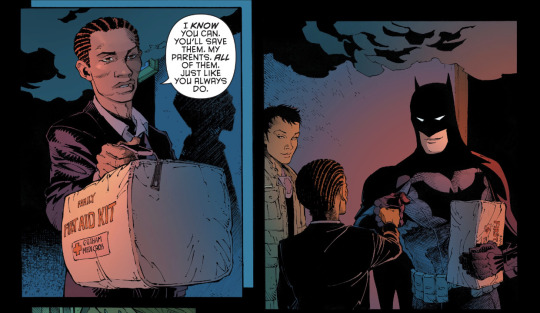
(Batman (2011) #37)
He’s definitely older! He’s wiser! And he’s giving Batman a fistbump lmao. Again, no strict age given here BUT, since they condensed each Robin to a Year or Two tops with Bruce (its n52 and its fucked up is what it is), we can assume it’s been at least 4-5 since Zero Year (which would mean if we go off the age range I proposed for that year, then theoretically he could be anywhere from 12-16 here, and I think that tracks pretty well. Not Perfectly and Certainly Not so well with Pre52 continuity ofc, but I’ll talk about that later!)
In We Are Robin, while its not stated Directly In The Text, it IS given as an Informational Tidbit that Duke is 16 (specifically this can be found at the end of issue #4)! (Sweet sweet canon confirmation FINALLY)
We know that WAR takes place Fairly Soon after Endgame (almost immediately, give or take a month or two given that Duke’s been placed in a few foster homes at this point and has racked up Quite A File) now, again id like to remind y’all that while this is a NICE starting point to have, keep in mind that comics are fluid and this may be retconned slightly/ignored in later stories bc Keeping Duke 16-ish is in DC’s Best Interest at the moment. (Having Relatable Teen Characters afterall is a Good Marketing strategy™️. And the longer they can Keep them Young, the Better)
With that in mind let’s take a moment to Highlight the fact that Duke and Damian have crossed paths at this point AND the storylines that have occurred during this year that were meant to be in conjunction with one another!
Because Prior to Endgame, Damian had Died! And just a year (in real, meat-space time) before We Are Robin, he was resurrected and had begun his “Year of Atonement” in the Robin: Son of Batman maxiseries. Midway through both this series and WAR (and, we can assume, midway thru this “Year” for Damian) the Robin War begins/ends and we see at least one major Moment between these two boys who will soon call one another brothers:
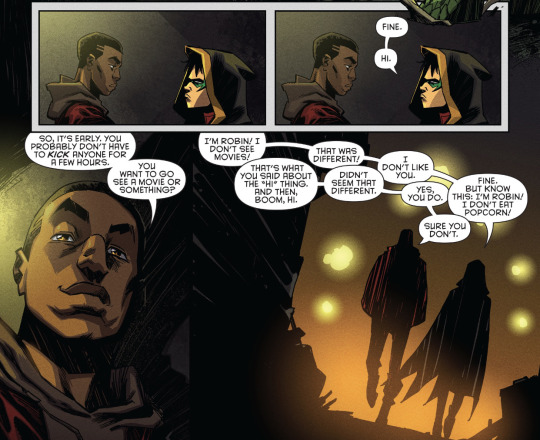
(Robin War #2)
Given that R:SoB is followed up VERY quickly by Teen Titans Rebirth (in which Damian celebrates his 13th birthday), we can conclude that Damian would be 12 during this time (well, 12 and 1/2 to play it safe lmao). That being said, this Confirms about a 4yr gap between Duke and Damian! (One Batkid down at least! but he’s the key to the others so put a pin in him!)
As We Are Robin draws to its conclusion, DC was releasing another arc that would eventually flow into the Rebirth Era, by the end of which, Bruce would approach Duke with an Idea (which involves Bruce becoming Dukes temporary guardian & as he states Many Times “Trying Something New” with Duke).
And thus the Rebirth Era begins, and Duke began his Year of training (most directly encapsulated by the Cursed Wheel arc in the All-Star Batman run:
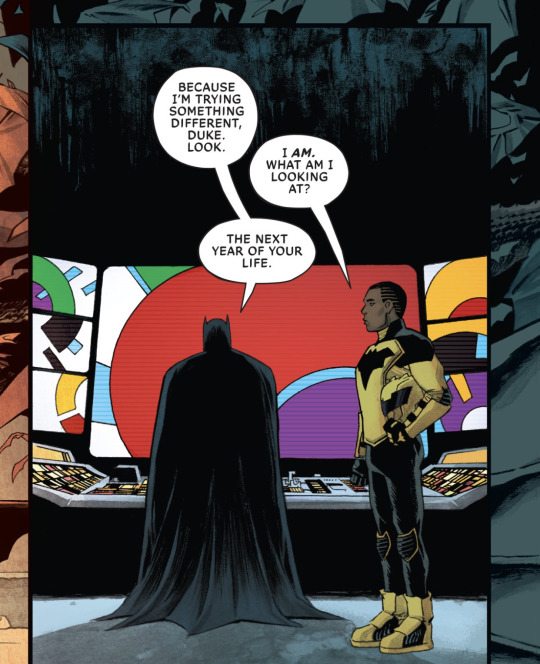
(All-Star Batman #1 (back-up story))
Bruce introduces Duke to a training regimen that Alfred has named “the Cursed Wheel”. It encompasses all the training Bruce and the other bats have undergone and condenses it down into color-coordinated segments that will take Duke a Year to Complete.
It can be assumed that by the End of this Year Duke will somehow miraculously still be 16, despite, again, an entire ass year passing.
There’s one story that takes place mid-year in All-Star Batman, and the Cursed Wheel is meant to be capped off by Duke’s first Official Day as the Signal (in the titular Batman & the Signal ofc) BUT, near as I can tell after this story, Dukes age is not brought up again. So until they DO bring it up either in Batman & the Outsiders or whatever future run Duke becomes involved in, we can assume DC will be working with the idea that he’s meant to be in that 16-18 range from here on out (ie still a minor).
But, dear anon, you might be saying “okay, that’s cool, but how does that relate to my question abt how he falls in with the other Bats?” You’ll have to be a little patient with me here, but I think I may have cracked the code!
Keep in mind I’m gonna be addressing both the Post-Crisis to Flashpoint Continuity (ie mid-80s to 2010 in comics history) and the N52-slash-Rebirth Era (2010-Today). Its generally agreed by fandom and DC alike that these points of rebooting &/or Major Events constitute the era of “Modern” comics, and that everything from the 80s-on might more or less be canon on some level, even if not All of it is.
(Plus, most of fandom usually likes to borrow elements from both eras and much more rarely from stories before it, SO-)
Lets do a quick rundown of how everyone who’s Closer to Duke’s Age, Relates to each other first, age-wise:
Given that Jason was 15 when he died, in A Lonely Place of Dying its established that Bruce had become increasingly reckless since his death, and by the end of the story, Tim has stepped in to fill Robin’s shoes (he states that he’s 13 during this story btw). Pretty soon after, Stephanie Brown is introduced & established to be about a year older than Tim (wish I could pin-point a specific issue BUT, i unfortunately haven’t read any Tim OR Steph-involved comics that predate No Man’s Land... Besides the aforementioned Lonely Place and Young Justice technically, but im working on remedying that soon!)
NOW, during the No Man’s Land event, Cassandra is introduced, and pretty soon into her Batgirl run, its revealed that she’s around the same age as Jason (or at least how old he Would Have Been, had he not died.) Now, given that Jay has an August bday and Cass has a January one, fandom sometimes likes to play around with the idea of one being older than the other (OR even speculating/placing them in an AU as twins/siblings, given that Lady Shiva (Cass’ mom) was a Possible Candidate to be Jason’s biological mother but that’s a Whole Other Thing i wont get into here.)
The point being, Cass, in this era of comics, IS slightly older than Tim and Steph. At Tim’s start as Robin, their ages could either line up like: Tim-13, Steph-14, Cass-15 (being a few months ‘behind’ Jay), then Jason at 15/16 (depending on how soon Tim filled the role after Jay died in April) OR Jason-15/16, Cass-16/17 (in this case she’d be a few months ‘ahead’ now instead)
So brief detour to talk New 52, however! Because Tim, Steph & Cass all got switched around from where DC originally left them prior to the reboot! Now I haven’t read much of them in this era, other than Batman & Robin: Eternal, so my Understanding of their current ages is Spotty at Best. The general consensus seems to be that while before N52, Stephanie had been attending her first year of College (& doing VERY WELL i might add), with the reboot she was set back a few years alongside Tim to a vague Late-Teen state (so 16-18-ish, instead of a Very Clearly Established 18/19). Cass is probably the worst off for this reboot, given that B&R:E basically constitutes her new origin for the new continuity, and does nothing to confirm her age (all I really know is that she’s a Vague Late-Teen too... Probably? Maybe?), given how much they infantilize her, and subsequently how fandom in turn has taken to infantilizing her too, theres a semi-popular fanon that places her Younger that Tim and Steph. And I, for one, propose that we ignore that bc its Weak Sauce my dudes.
Some fans chose to ignore N52 continuity due to this vagueness, and will stick to the ages established before the N52/Rebirth reboots. But its something to keep in mind regardless bc we’re all obviously going to pull from what’s most familiar to us!
But WHERE could we place Duke with regards to them, then? Because them being “Late Teens” is certainly much too vague to work with!
This is Where Damian is the key!
Because Damian is one of those rare exceptions to the Reboot Rule. His story flowed almost seamlessly over from before to after. While he was made a Robin at the age of 10, he continued to grow and learn even after the universe was being rewritten to suit the whims of DC editorial.
If we choose to ignore how everyone else’s ages and origins were swapped around, and stick with the growth that was presented before the reboot, then we can draw some interesting conclusions!
Firstly, though Stephanie also had Died and subsequently Returned, she hadn’t lost much, if any time, from the Ordeal. At the start of her Batgirl run, she is enrolled at a Gotham university and making headway with a more firm foot in the Batfamily (even to the point that she and Damian spend a few issues bonding. At this point in time, Damian is definitely 11, and again, Steph can be assumed to be 18/19 during the course of her run. We’ll assume 18 for clarity’s sake.)
So, then when Damian is 11, now our line up is as Follows:
Dami - 11, Steph - 18, Tim - 17, Cass 19-21 (the range depending again, if you subscribe to Cass being either older/younger than Jason).
WHICH MEANS, If during Robin War Damian is 12 (and a half) THEN We’ve got an age line-up that Potentially looks Like This:
Dami -12(and 1/2), Duke - 16, Tim - 18, Steph - 19, Cass - 20-22 (And Obvsly Jason, Babs & Dick at their varying Older Ages than everyone here)
and im just now realizing i Didnt include Harper in this line-up, but thats bc she’d also throw a big wrench in all this. I’d personally throw her in with being Steph’s age, but I’m pretty sure she was supposed to be either that, or between Steph and Cass (again, since its N52, i believe Cass was/is assumed to be Younger than Steph, but that contradicts the assumed following of pre52 canon that we have for the above line-up, obvsly, and so we ignore that lmao)
All this to say, however, that canon and fandom is what you make of it, and if you want to wiggle these ages around a little, you’re more than allowed! God Knows i usually like to skew the Tim-Steph-Cass age group to be a tad older than this in my own fic writing, and I like to have Duke start as a Robin at 14/15 instead of 16, but that’s just bc I like the dynamic potential it could bring with them being Definitively Older that him, and thus in a more secure place to be Mentoring him right alongside Bruce & the others.
But you might see these age ranges and want to do something Different (say, making Tim, Steph, Cass, & Duke all the Same Age at 17 instead! And that very well tracks with how current comics kinda looks right now!) and you’re absolutely valid to do so! Because again, comic character’s ages are meant to be fluid, not fixed!
And at the end of the day, its all about wanting to see these teen heroes kick serious ass haha
#duke thomas#guest starring:#batfamily#damian wayne#tim drake#stephanie brown#cassandra cain#randywrites#randys meta#meta#asked and answered#anonymous asks#this was A LOT and i tried to throw some humor where i could#but uhhhh yeah!!! i hope this helps anon!!!#also just realizing its TWO AM WHERE DID THE TIME GO#ah well. Worth It
125 notes
·
View notes
Text
Robotics;Notes Elite review
Robotics;Notes, the third visual novel in the Science Adventure series, is by far the most unfortunate entry in the series. Not only is it the follow up to Steins;Gate, one of the most acclaimed and popular visual novels ever released, something that even extends to its anime adaptation, but it had to wait until 2020, 8 years after its release in 2012, to be translated into English, well after every other main entry in the series besides Chaos;Head, with its anime adaptation being the only way to experience it beforehand, and while said anime is a decent watch in its own right, it definitely accentuates the source material’s problems, while adding several more. Needless to say, Robotics;Notes had a lot of things going against it when it was finally released, most of which weren’t even its own fault, and it can definitely come off as an underwhelming entry just from that. However, today, we’ll be putting aside all those external factors and take a fair look at the VN itself, and how it holds up on its own. The version I played was the Steam version, using the Committee of Zero patch, a fan made patch that, among other things, fixes many issues with the translation, and is absolutely the recommended way to experience the VN.
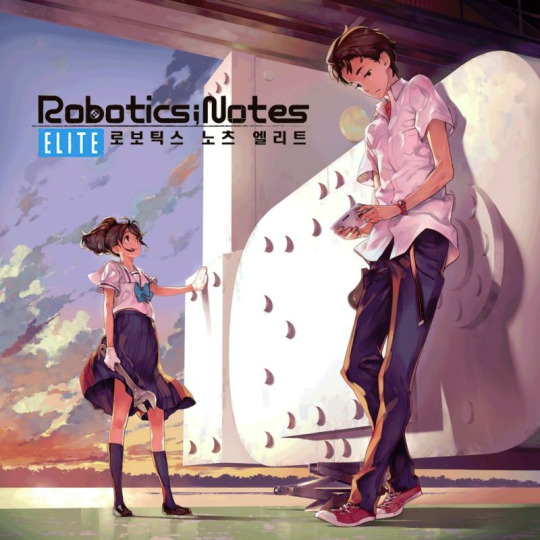
Kaito Yashio is a student of Chuo Tanegashima High, and one of the two members of its Robotics Research Club. The president of the club, Akiho Senomiya, Kaito’s friend since childhood, and little sister of the club’s founder, Misaki Senomiya, is completely committed to completing GunBuild-1, a lifesize recreation of the titular mecha from the extremely popular anime Gunvarrel, and a project the club has been working on since its creation. Unfortunately for Akiho, everything seems determined to see her efforts be in vain. The club gets no funding, and is seen as a laughingstock among the students, its advisor, Mitsuhiko “Mitchie” Nagafukada, is completely irresponsible and rarely does anything of help, and Kaito is completely apathetic to anything that isn’t KillBallad, a mobile fighting game he’s determined to become the top player in the world in. While the club soon manages to gain three new members, namely Subaru Hidaka, an expert in robotics whose knowledge far surpasses Akiho’s, Junna Daitoku, a former member of the karate club, and Kona Furugoori, aka Frau Koujiro, the teenage creator of KillBallad, their personalities are just as difficult: Subaru sees the project as a lost cause, and refuses to help with it without a compromise, Junna is painfully shy and has a fear of robots, and Frau is a complete shut in and social mess, being completely perverted and mostly talking in outdated slang, which keeps most people from even understanding her. Despite all this, Akiho’s unrelenting passion for mechas, and desire to step out of her sister’s shadow, compel her to continue on.

Meanwhile, Kaito one day encounters Airi, an AI that exists within the augmented reality app IRUO, along with a strange AR annotation called the Kimijima Report, authored by Airi’s deceased creator, Kou Kimijima. Within it are warnings of a grand conspiracy that aims to devastate humanity, the details of which are contained in similar reports hidden all over Tanegashima, locked behind “flags” that must be cleared before they become visible. Though at first skeptical, it soon becomes clear to Kaito that the reports contain a disturbing amount of truths, and that he’s become involved in something far larger, and far more dangerous, than he bargained for.

I’ll say it now, the story’s focus on both of these plotlines causes a number of noticeable issues, mainly due to feeling very disconnected from each other. While all of the main cast except Airi are heavily involved in the Robotics Club plot, only Kaito, Airi, and to a much lesser extent Frau are involved in the Kimijima Report plot, in comparison to, say, Steins;Gate and Chaos;Child, which tied its whole cast into their stories much better. In addition, the majority of the focus is on the club, and though always interesting, the reports tend to go rather uneventfully as well. Due to this, the story can feel very slow and meandering if you don’t know just what you’re getting into, much more so than the other entries in the series, which can definitely make it seem unappealing. Additionally, the story is much less standalone than most SciAdv VNs, where the references are often minor. Here, there are some rather significant references to Chaos;Head and, to a lesser extent, Steins;Gate, to the point of outright spoilers in a few cases, meaning going through those beforehand is heavily recommended, which is especially annoying when Chaos;Head still has no official translation, and only a fan translation for the incomplete PC version.
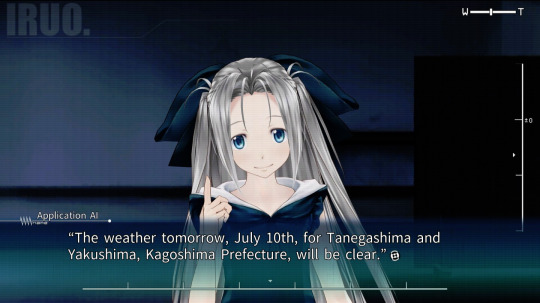
Despite all of this, both plotlines are actually quite compelling, once you get used to the game’s pacing. Robotics;Notes’ biggest strength is its absolutely great cast of characters. Everyone in the main cast is very likeable, distinctive, and well developed across the story, and have good dynamics with each other, with Kaito and Akiho’s interactions being some of the biggest highlights of the game, with the end result making everyone feel significant in their own ways, and truly feeling like a unified group, something Chaos;Head and even Steins;Gate struggled with at times. Kaito, who initially comes off as a very motivationless character, has a good amount of backstory and a constant, if subtle, arc throughout the game that makes him properly fleshed out. Subaru, who’d normally just be the token other guy, is a prominent and likeable character in his own right, having a very important role in Gunbuild’s construction, while Frau, who initially just comes off as comic relief, has many great moments throughout the story, with her focus chapter in particular being one of the best in the game. Even Airi has quite a bit more to her than it may seem. The cast is definitely a worthy successor to the cast of Steins;Gate, even more so than Chaos;Child’s, I would say.

The cast also heavily ties into one of the main themes of the game, namely dreams, the harsh difficulties and compromises one faces in pursuing their dreams, and how losing one can change a person. All of them face this, with varying amounts of focus, and it’s a theme furthered with the prominence of robots throughout the game, both the idealized kind found in mecha anime, and the real, practical robots of the real world. There’s an almost exhaustive amount of detail put into the construction and function of real robots, which makes for some interesting, if sometimes long winded, discussions throughout the game, in true SciAdv fashion.
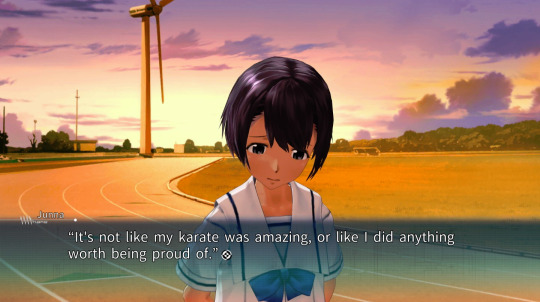
While the story is mainly told through Kaito’s perspective, it switches fairly often to other characters, most often Akiho. While the rest of the series except for Steins;Gate does this as well, it’s notable here for giving almost every character, even the supporting cast, at least one scene from their perspective, often focused on their own personal dilemmas, or flashbacks involving Misaki. These perspective switches make a nice change of pace, and definitely help flesh out the characters even further. On the subject of the supporting cast, while most other entries either have supporting casts that are very inconsequential, such as in Chaos;Child, or almost nonexistent, such as in Steins;Gate, Robotics;Notes, on the other hand, has a much more prominent and fleshed out supporting cast. From Mizuki Irei, the harsh and snarky convenience store employee, and info broker to Kaito, to Tetsuharu Fujita, the grumpy but fair “Robot Doctor”, to Mitchie, the horribly unreliable, yet entertaining club advisor, they certainly leave much more of a mark than usual. The most interesting of all, though, is a 20 year old Nae Tennouji, originally a very minor character in Steins;Gate. She has an almost surprising amount of prominence throughout the game, and even has her own ending, if a very short one.

Compared to most other entries in the series, Robotics;Notes definitely carries a much lighter tone. Tanegashima makes for a very relaxed setting, and as mentioned, there aren’t quite as many big events as one might expect. The characters are generally pretty lighthearted in personality as well, up to Kaito not being nearly as unlikeable to start off as other SciAdv protagonists. However, the tone works quite well, and helps slowly endear the characters to you even early on. And while it’s not quite as messed up as, say, Chaos;Head, it’s got more than a few disturbing elements and scenes of its own. Ultimately, it has the same “feel” as the rest of the series, and when it wants to be intense, suspenseful, sad, or whatever else, it absolutely works, especially from chapter 7 onward.
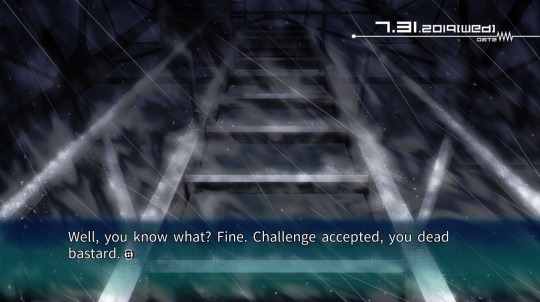
As far as “gameplay” goes, there’s a surprisingly large amount of interactivity available. At most moments during the story, Kaito can pull out his tablet and access its various apps. Most prominently, there’s Twipo, an obvious lawyer friendly version of Twitter, where Kaito can look at tweets from the Robotics Club, its associates, and even random accounts commenting on current events, with Kaito having the option to reply to those of the Robotics Club. There’s also IRUO, the augmented reality app, which lets the player look around the area and scan geotags, which contain small profiles for characters, or details for locations or objects. IRUO is also used along with a map app to search for the Kimijima Reports, letting you travel to various different locations on Tanegashima to search. It’s a neat concept, but the icons for the reports are so small, and so many locations tend to be available at one time, that finding them can often just be annoying. There’s also, of all things, the otherwise story reliant KillBallad matches, where you have to successfully input a string of buttons, the length of which varies depending on the opponent’s skill, within a time limit in order to win. Most of the time it doesn’t matter, but there are achievements and even story sequences reliant on winning or losing certain matches. All in all, these make for nice occasional changes of pace, but it’s still a visual novel in the end.
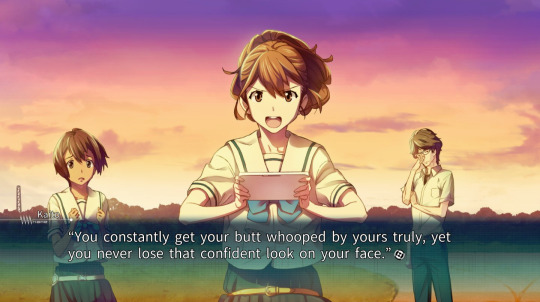
Visually, Robotics;Notes is actually quite impressive. As can be seen in the screenshots, instead of sprites, 3D character models are used instead in normal scenes, and having played Virtue’s Last Reward and Zero Time Dilemma well before this, I was more than a bit wary of them before release. Thankfully, compared to the cheap models of those two games, they’re much, much better. They’re actually very expressive, and have some great animations that give each character a lot of life. The backgrounds are also quite well done, and Tanegashima definitely makes for a unique and atmospheric setting. As usual for visual novels, there’s also CGs throughout the game, done in a different, but still appealing and well drawn style. Finally, in one of the biggest additions to Elite compared to the original version, occasionally, clips from the anime adaptation is used, mostly to better demonstrate details that were only narration originally, as far as I can tell. This blend of 3D models, CGs, and animation is a bit bizarre at first, but it works surprisingly well, and makes for one of the most visually appealing entries in the series.
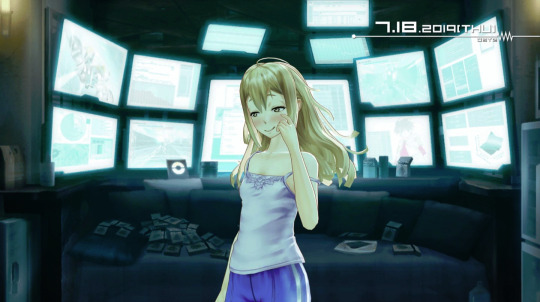
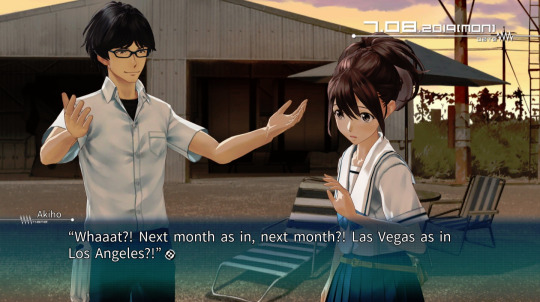
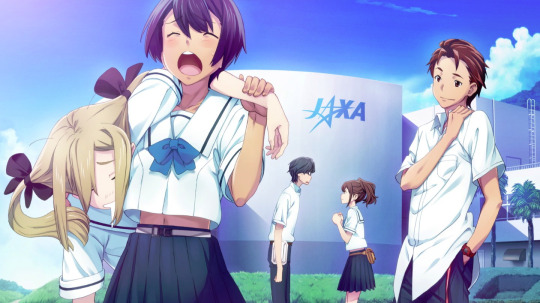

As far as sound goes, Takeshi Abo is once again the composer, and once again puts out a very good soundtrack, which further captures and enhances the atmosphere. The soundtrack in general is definitely much lighter and peaceful than usual, but actually has more tracks than most of the SciAdv soundtracks, allowing it to cover many other moods as well. From the very relaxed Winds of Tangegashima, to the mysterious Uchugaoka Park, to the nostalgic Memories with Big Sis, and especially the beautiful title screen theme, Robotics Notes -2nd theme-, there’s a lot of great songs to be found. The voice acting is also very good, and the characters wouldn’t work nearly as well without it, with Ryohei Kimura as Kaito, Yoshino Nanjo as Akiho, Kaori Nazuka as Frau, and Sora Tokui as Junna especially sticking out to me.
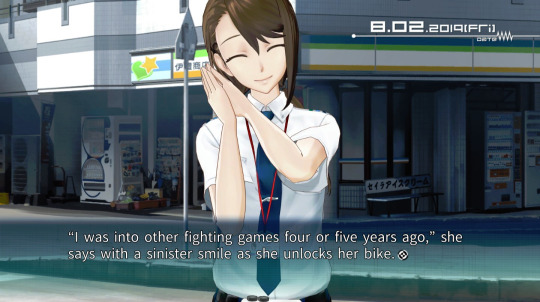
It’s worth noting that Robotics;Notes is on the longer side when it comes to SciAdv, much like Chaos;Child. It’s hardly Fate/Stay Night, but it’ll take some time to get through. It also has a very, very weird and annoying ending system. Whereas in other titles, endings are, just that, actual endings you can diverge into somewhere in the story, Robotics;Notes’ endings are actually just regular chapters that are part of the main story, which just happen to focus on different parts of the cast. The divergence happens in chapter 5, and depends on your replies to said characters on Twipo in both that chapter and the preceding one, with you instead going to the short Nae ending if you don’t fulfill the requirements for any of them. While Steins;Gate had a similar system, and was annoying in of itself, Robotics;Notes takes it to another level by making all but the Nae ending mandatory, though said ending has some points that make it worth seeing regardless, and occurring in a specific chronological order, despite allowing you to get the endings nonlinearly, meaning you could accidentally skip from chapter 5 to chapter 8. The system overall is just unneeded, and following a guide, such as the one by the aforementioned Committee of Zero, is highly recommended.
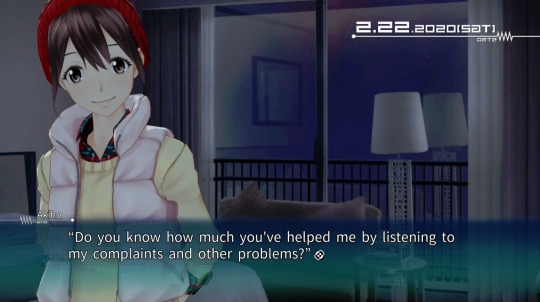
In the end, would I recommend Robotics;Notes? To a SciAdv fan, absolutely. To someone who isn’t, well, I already explained the problems there. I can’t say its one of my favorites among the series, but by itself, it’s still something I enjoyed a lot. Despite the issues it does have, its very well done cast, visuals, sound, and overall story make it a memorable and emotional experience in its own right. Now, with yet another long VN review out of the way, I anxiously await the Committee of Zero patch for Robotics;Notes DaSH, to finally finish off my SciAdv journey, for the foreseeable future, at least. Till next time. -Scout
31 notes
·
View notes
Text
Just how important IS Hooty?
You know, I can’t help but wonder if some of the secrets and codes in the episodes have been working as a bit of misdirection, diverting our attention away from the deeper mysteries tucked underneath the surface.
After all, I’ve been seeing plenty of speculation about stuff like Eda’s curse, the Boiling Isles titan, and King’s backstory/possible true form, but not a whole lot about the titular Owl House itself, the silly goofball pictured below:
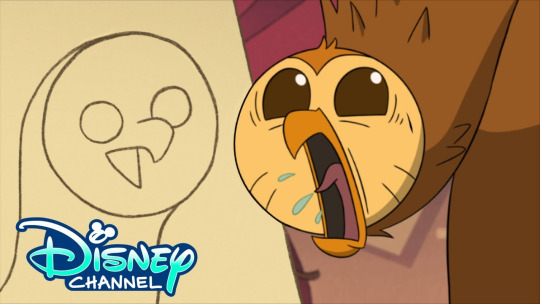
Now, to be fair, he is particularly easy to overlook due to the lack of focus and weight given to him and his actions beyond the apparent role of sheer comedic relief, and much of what he has said is rather dumb-sounding with others emphasizing how annoying his voice is, but it feels very telling to me that this whole show isn’t named after Luz and Eda or their adventures in particular.
I mean, while the show has mainly been focused on the main characters of Luz, Eda, and King, they are the inhabitants of the Owl House, not the Owl House themselves, and with the way this show likes to reframe seemingly minor jokes and offhand lines as important in later episodes, I get the sense that the same might especially happen with Hooty but on a much grander scale.
We’ve seen throughout the series how he can manipulate different parts of the house like the weather vane and shutters, and in Hooty’s Moving Hassle alone, we both learned that the walls literally breathe and had the demon hunters - who were noted at the beginning to capture and sell the most powerful beasts - view Hooty as some sort of house demon tied to the house.
Though the latter could possibly be chalked up to the demon hunters mistaking a powerful display of animation magic from Luz, Willow, and Gus as a demon, the way that Hooty grew feet and the kind of aesthetics with the house’s design makes me wonder about the kind of importance Hooty could potentially be revealed to have.
Namely, that he either used to be or will become one of THE most important, powerful characters on show.
As @elementalist-kdj has noted before, the stained glass eye window of the Owl House comes from the tower behind it, but it has always struck me about how closely the whole house resembles the owl mural - or perhaps the Owl Deity as I’ve speculated before.
For those who don’t know, I’ve made a post before about how the mural and a few other parts of the Owl House seem like they could have come from some kind of temple or building dedicated to an owl spirit/deity that Eda may have found as a kid rather than having made it herself, and said “Owl Deity” appears to be reflected in stuff like Owlbert’s depiction on Eda’s wanted poster and etc, with particular focus on the following:


Obvious house geometry and chimneys aside, the front of the Owl House to me looks both like a more abstract and more realistic depiction of the Owl Deity than the mural itself. For comparison, let’s look at an actual life horned owl, one with brown streaks and a white spot in lieu of triangles and a diamond shaped star:
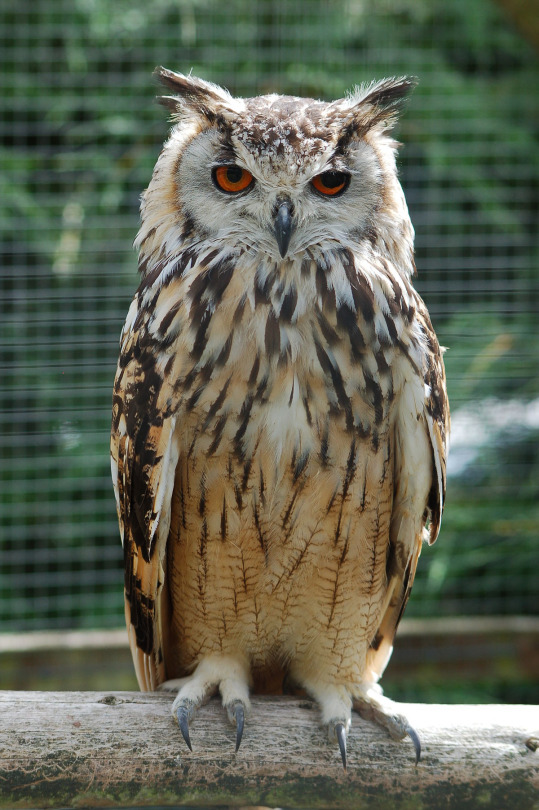
The dark brown streaks in the chest plumage are hardly uniform or symmetrical, and the kind of “diamond shaped star” that can be imagined with the spot of white in the center of this owl’s chest is less outlined as a clear star and more as a splash of color.
Now, with the Owl House, all of the glass windows on the front besides the eye-shaped one could be abstracted into right side up triangles while at the same time realistically varying in size and placement just like a real owl. And just like the white splash of color in the above picture, the door - aka Hooty - is placed roughly around the same spot on the house as the diamond on the Owl Deity in the mural. Heck, the owl weathervane could be interpreted as a stand-in for the subtle flame/crown above the Owl Deity’s head.
Just turn the eye-shaped window ninety degrees, make the outside more feather-like, and add some horns/ear tufts above the eye, and you could get what would likely look to be a more accurate version of the Owl Deity - albeit one with the wings tucked in as if roosting rather than spread out in flight - with some slight alterations to the feet of the following picture and getting rid of all the dirt right below the house and above the legs:

All in all, what I’m suggesting is that - as Hooty IS the Owl House itself - he could be either a reincarnation of/a new vessel for/an aspect of the Owl Deity, or a severely weakened and amnesiac Owl Deity that Eda had discovered and incorporated into her house.
With this, I believe that the power of the Midnight Conjuring and its effects on Hooty could be an indication that it would require both a LOT of magical potential/power to restore/bring back the Owl Deity in full force, AND the correct spell or ritual to do so.
Obviously, Luz and her friends easily fulfill the first requirement with their showing in Hooty’s Moving Hassle, but that incident merely channeled that power through Hooty rather than into him, and as such, Hooty’s true potential only partially manifested itself with very limited independence.
Heck, it didn’t even manifest in the correct manner at that, what with the feet in the above failing to match the kind of feet the Owl Deity and the IRL owl have as @sepublic‘s pointed out to me before, so to me, the implication seems to be that for as powerful the combined might of Luz and her friends under the Moonlight Conjuring was, that is still just a flash in the pan compared to the sheer amount of power required to actualize the entire Owl Deity.
As for what is the exact relationship between Hooty/the Owl House and the Owl Deity, I suspect that it could be related to how Hooty’s been often described as the house’s defense system and ‘guardian’ both in and outside of the show, and if my theory about the mural and curtains having come from just one of many rooms out of a whole temple is correct, then maybe the Owl Deity is a guardian being that has a mutually symbiotic relationship with its supporters.
Specifically, a being that is the temple housing said supporters itself.
In exchange for offering protection and maybe even some ancient wisdom as befitting the traditional image of a large and incredibly powerful owl in pop culture, its followers may have taken up residence within this temple and ritually offered to help bolster the Owl Deity’s strength and abilities with their own magic, which helps it more easily manifest its true power and knowledge.
However, I’d like to propose that something might have happened to the Owl Deity’s followers a long time ago, whether from something like all of them dying or being killed, the Owl Deity having fallen in some kind of battle or fight and such that led to its followers being forced into hiding, or its supporters somehow being swayed over to the side of someone else - perhaps someone with a closer association to corvids and ravens rather than owls.
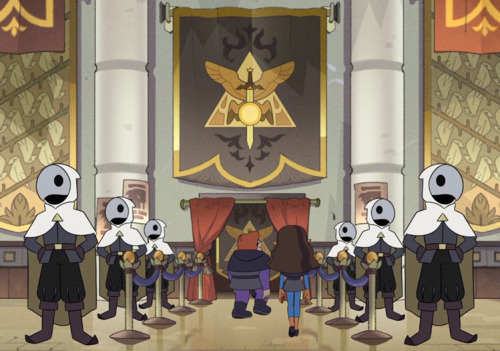
From there, the Owl Deity lost a good amount of its power and strength, its temple body eroding away by the currents of time and its legacy falling into complete obscurity until a chance discovery by a young Eda Clawthorne during her studies at he Hexside School of Magic and Demonics.
And within these ruins, she found a miraculously intact room containing the owl mural and its associated curtains, among which she also uncovered a young/infant owl-like ‘house demon’ she brought back with her, eventually giving it the name “Hooty.”
Though I know the justifications for this theory are admittedly rather circumstantial and flimsy at the moment, I just can’t think of any other conclusion that feels anywhere close as likely to actually happen within the show.
I mean, a very recurring semi-major character often being the only one constantly being re-established as ‘just silly comedic relief’ among a whole cast of characters whose small quirks and funny antics constantly returning to show hidden depths?
And the owl mural itself - a topic of much theorizing - is a part of the owl house and therefore part of Hooty himself much like the breathing walls in the ‘living’ room, so wouldn’t that mean that Hooty has a MUCH closer relationship with it?
How about all the points brought up about how Hooty is supposedly a “state of the art defense system” and how Eda has a LOT of people after her who ought to have been able to get past Hooty despite his many showings of incompetency?
Either all of this is just coincidental set dressing and have no actual bearing on Hooty and his role in the story, or this is all part of a massive bait and switch where, between the idiocy and comedy, things are subtly building up towards a MAJOR demonstration of just why the show itself is named not after any of the inhabitants of the Owl House, but after Hooty himself.
#the owl house#owl house#owl house theory#the owl house theory#hooty#theory#speculation#long post#amnesiac owl deity hooty theory
264 notes
·
View notes
Photo

Week 1: Understanding Korean History
To say I was excited to join the first session of the KPA was an understatement - I had my notebook, coffee and highlighters at the ready like a nerdy highschooler on her first day at school (yes, I was that girl). After a round of introductions from fellow KPA-ers, we kicked off Week 1 with an in-depth lecture from Dr Anders Karlsson (Senior Lecturer in Korean at SOAS, University of London) who took us on a whistle-stop tour through Korea’s illustrious history.
I don’t know about you, but sometimes I find ancient history a bit…inaccessible (*ahem* boring). So I thought I’d combine this week’s homework of presenting a (very) brief outline of ancient Korean history with a passion of mine: K-dramas, specifically that of historical Korean dramas or sageuk (사극). Maybe it’s the sumptuous costumes, the swashbuckling sword fights and horse riding scenes, or just my overly-romantic notion of the past, but it’s a genre that I’ve consistently been drawn to.
Prehistoric Korean history Dr Karlsson mentioned that most records of Korea’s early history have been destroyed, making it difficult to pinpoint when exactly these early civilisations came to be. However, it has been noted that even all the way back in 2000 BC, rice cultivation was already well-established around the Korean peninsula. The Bronze Age came to the tribes in the area at around 700 BCE and then, around 300 BCE they moved into the Iron Age, as noted in Chinese records for the first time.

Dramas set in this era are extremely uncommon - and probably for good reason. In fact, the only one I know of is Arthdal Chronicles starring Song Joong-ki which turned out to be…a bit of a train wreck. It’s supposed to be a fantasy drama (think Korean ‘Game of Thrones’) that happens during the Bronze Age and is ‘loosely based’ on the creation story of Dangun, the son of a heavenly prince and a bear-woman. Legend has it he goes on to build and rule the kingdom of Gojoseon (‘old Joseon’) in 2333 BCE, but Dr Karlsson points out those timings don’t seem to add up with historical records.
Three Kingdoms Period (57 BC - 668 AD) Around this period, the Korean peninsula was mostly dominated by tribes but by 57 BC, the kingdom of Kingdom of Silla emerged, followed by the founding of Goguryeo in 37 BC by Jumong (there’s an old but much-loved drama by the same name) and finally with the founding of Baekje in 18 AD by Jumong’s wife and her sons. These three kingdoms were heavily influenced by Chinese civilisation, especially with the spread of Confucianist thought and Buddhism which arrived in the 4th century.
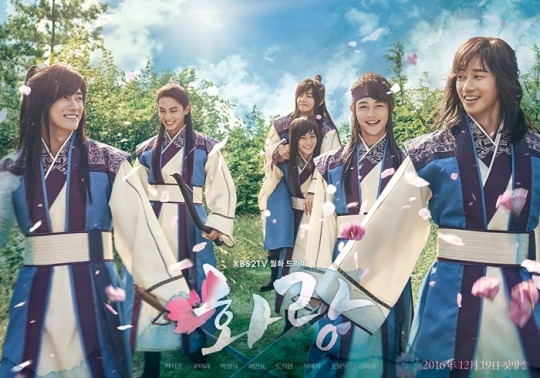
The only drama set in the Silla period that I’ve briefly dabbled in is Hwarang: The Poet Warrior Youth which stars an A-list cast (Park Seo-joon, Go A-ra and Park Hyung-sik) but I’m sure is simply an excuse to put a bunch of very pretty looking boys in warrior uniforms. (I mean, hwarang literally translates as ‘flowering knights’ so case in point.)
Goryeo (918 - 1392) We fast forward to the founding of Goryeo which brought about ‘true national unification’ through centralisation of power, bringing under it the aforementioned three kingdoms as well as the northern kingdom of Balhae. One of the most well-known dramas set at the beginning of this era is Moon Lovers: Scarlet Heart Ryeo (starring IU and Lee Jun-ki) which, thanks to its stellar acting but unsatisfactory ending is equal parts loved and hated among the drama watching community. (I just realised this is another drama with another all-star cast of very pretty men - are you spotting a pattern here? Haha!)
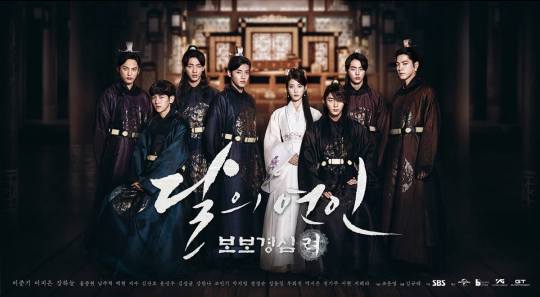
Joseon dynasty (1392 - 1910) The majority of sageuk that I know of are based somewhere within the 500-odd years of the Joseon dynasty. There is a wealth of material to work off - be it the kingdom’s relationship with the neighbouring Ming dynasty, various Japanese and Manchurian invasions, as well as Neo-Confucianism taking over as the new state ideology.
It was also a time of great progress - the Great King Sejong created hangul, the native Korean alphabet in 1443, as sweetly depicted in one of my favourite fusion sageuks, Splash Splash Love, starring cute-as-a-button Kim Seul-gi and idol actor Yoon Du-joon. It’s just a 2-episode mini drama, but manages to pack in so much cross-dressing and time travelling hijinks, as well as incredibly well-fleshed out characters.

After fighting off a Japanese invasion (1592 - 1598) and Manchu invasions (in 1627 and 1636), late Joseon saw itself as a bastion of civilisation and successor to a waning Ming dynasty. However, the West soon came knocking at its doors. Another time-travel drama, the recently completed Mr Queen, is a gender-bending portrayal of the titular Queen Cheorin (1837 - 1878) set towards the end of the Joseon era. While this wacky but highly enjoyable drama is blatantly inaccurate historically, it references the Donghak movement, a Neo-Confucian philosophical ideology which came about in response to seohak (‘Western learning’) which arrived to Korean shores via Catholic missionaries.

The influence of Western ideology on late Joseon is further explored in Rookie Historian Goo Hae-ryung through a minor story line involving a Jesuit priest who disseminates his medical knowledge of vaccinations to combat smallpox, a disease rampant at the time. While Goo Hae-ryung, a female historian, is a historical impossibility and thus purely a work of fiction, her awareness of the importance of history and the accuracy in which it is recorded is summed up beautifully in this moving soliloquy, delivered whilst on her knees, with sword at her throat:
“Even if you slash my throat, our brushes will not stop writing. If I die, another historian will take my place; if you kill that historian, another will take their place. Even if you kill every historian in this land, and take away all the paper and brushes, you won’t be able to stop us. From mouth to mouth, teacher to student, elder to child, history will be told. That is the power of truth.”

As such, our first lesson on Korea’s ancient history was such an important one - it gave us the context in which to understand Korean culture as an accumulation of struggle, war, peace and progress through millennia. The fact that its history can be enjoyed so thoroughly through sageuk is just another of the many reasons why I’m a lifelong fan of K-dramas…not that I needed any excuses to watch them in the first place!
19 notes
·
View notes
Link
Warning: The following contains major spoilers for Zoey’s Extraordinary Playlist. Proceed at your own risk!
Oh, how the tables have turned! Zoey’s Extraordinary Playlist wrapped up its second season on Sunday with a heart song — but this time, it was Zoey doing the singing! And on the receiving end of her musical declaration of love was Max, who could suddenly hear Zoey’s heart song!
Prior to that cliffhanger, Zoey and Simon had split up, and then the titular gal got a dream visit from her dad, who encouraged her to take risks and really live life. So Zoey decided to rush to the airport to stop Max from leaving for New York City with Rose. But when she got there, she heard Max sing “When a Man Loves a Woman” and left without saying a word, assuming the tune was about Rose. However, when Max unexpectedly showed up at the park where Zoey was sitting forlornly, it was obvious the ode was about her.
Max explained that he and Rose broke things off because they could both tell his mind was on someone else. Then as Zoey declared that she was all in, she started to break out in a rousing performance of Modern English’s “I Melt With You,” shocking a bewildered Max.
Below, showrunner Austin Winsberg breaks down the big powers twist and what it means for Max and Zoey’s romantic future. (And for the latest intel on Zoey’s Season 3 odds, keep tabs on our 2021 Renewal Scorecard.)
TVLINE | What excited you about this twist with the powers and what it opens up for a potential Season 3? I’m always trying to think of new ways that we can twist and spin and do new things with the powers. We had talked about this pretty early on in Season 1, the idea of Max getting the powers at some point. Certainly, when you think of superhero origin stories, there seems like there’s always a place in the superhero shows where they find somebody else who also has powers. So we liked the idea of being able to do our own version of that.
But the other thing that we had really established a lot in Season 1, especially in Season 2, as well, was this idea that Max feels like there’s an inequality in their relationship, because Zoey has the ability to hear what’s going on in his heart, in his brain, and he doesn’t get to do the same with her. I think in any relationship in life, there needs to be some degree of equality in order for the relationship to work. So just in terms of thinking how could Zoey and Max work long-term, for me, it was important for Max to have an understanding of what it’s like for Zoey to experience heart songs. And I also like the idea that Max could know what’s going on in Zoey’s head as well. And certainly, from a romantic comedy perspective, to be able to play stories where these two people are in a relationship, but they also know exactly what the other person is thinking about, felt like ripe ground for storylines.
TVLINE | To clarify, both Max and Zoey have powers at the end of the finale? Or is it that the powers have transferred from Zoey over to Max? I don’t want to clarify that entirely yet.
TVLINE | Zoey is sometimes a guarded person. So how will this impact her, and how will she feel about Max having all this insight into her? That’s all stuff to explore in Season 3. But I certainly think that it opens up a whole new area of stories to tell, stories about him experiencing heart songs, stories about her having to help him with heart songs, stories about him hearing her heart songs and what that means for their relationship. It just adds new interesting layers of complexity and complication.
TVLINE | Zoey’s heart song was so exuberant, so joyous and free. Were there other songs that were in consideration for that moment, or was it always “I Melt With You”? For some reason, that was the song I kept going back to. Obviously, there are a lot of love songs out there. We might have danced around a few others. But it just always felt right to me. It felt right for Jane [Levy’s] voice. I liked the idea that the first song we ever heard in the pilot was “It’s the End of the World as We Know It,” and this song [goes], “l’ll stop the world and melt with you.” I thought there was some nice bookend world specificity to both of those. I liked that she said, “Making love to you was never second best,” after the whole Zoey/Simon/Max of it all. There was just something about it that felt very right to me, so I stuck to that one pretty quickly.
TVLINE | Speaking of the whole Zoey/Simon/Max of it all, talk to me about Zoey’s choices with regards to Simon and Max in this episode. What went into the thinking behind those decisions? When I mapped out the arc of the season, from the very beginning, I wanted to make sure that Zoey wasn’t indecisive and vacillating between both guys and not making moves in either direction. So I really felt like what was going to frustrate audiences with this idea of Zoey not picking either one. And so we made a conscious choice that I thought was a bold choice for her to choose Max at the end of Episode 1, and for them to at least try to do that and sort of realize pretty quickly that it’s still too early in her grief for her to really be ready for a relationship.
I did feel like because of the dynamic that had been created between Zoey and Simon, and the chemistry between them, I felt like that Zoey really needed to play that out in some way. And we found as we were breaking Episodes 9, 10 and 11, and dealing with the relationship stuff between Zoey and Simon, that there was a fundamental thing that she was keeping from him, which is telling him about the powers. I think that she was afraid to really open up to him that way and afraid of what that might mean, especially since their entire way that they met in the pilot was predicated on a little bit of deception in some way. I think she just didn’t feel like she could be open with him or wanted to be open with him in that way, and then the power kept getting in the way of things between them. It just felt like they were both trying really hard to make it work. So I liked the idea of exploring something where the fantasy of it or the expectation of it is maybe not as rewarding or fulfilling for either of them when they’re actually in it. It was always leading to this place, for me, that Zoey and Simon were going to break up at the end of the season, and then to see how it played out with her and Max.
It was just important to me to not make Simon feel like the victim in it, to not hurt Simon. That’s why I wanted him to be the one to say, “I think we should break up,” and then to also give Simon his own victories in the episode [as the boss of SPRQ Point’s new minority-run acquisition], because we’ve seen Simon at his depths of despair in Season 1, and I didn’t want to end in that way. I wanted to end him in a more positive, forward-facing place and feeling like he’s excited about the future.
TVLINE | Between the breakup with Simon and Zoey, and Zoey’s declaration to Max at the end, is it safe to say the love triangle is officially concluded, and moving forward, it’s about Zoey and Max giving it a real try? Certainly, my intentions going forward are that she and Max are going to try to make it work in a real way. And I don’t have intentions to uproot that or implode that, but it’s also TV storytelling. You have to create complications and challenges in relationships. Otherwise, if there’s no conflict, you don’t have a show. But certainly, my intention moving forward is to approach Zoey and Max dating and being together in a meaningful way, for them to try to work out their differences and their challenges together.
TVLINE | It seemed like a very deliberate and mature choice to have Zoey come to the airport and not stand in the way of Max and Rose. But then it ends up being on Max to make the first move. So how did you come to the conclusion that that’s the way the chain of events needed to go? In the spirit of not wanting to pit women against women or men against men, and what that would actually look like if you approached someone outside of the airport and said, “Pick me over her,” it’s pretty dramatic. I also felt like there was a delightful mislead that she hears him sing “When a Man Loves a Woman,” and she thinks that’s about Rose, and fundamentally, Max’s happiness is what’s more important to Zoey, and she doesn’t want to take that away from him. And so even though the reveal at the end is that he was actually singing that song about Zoey, I think that Zoey and Max have always had the other person’s best interest in mind, as evidenced when he gave up the job for her in the last episode. So I think for her, that was that wakeup call moment, where his happiness was more important to her than maybe her own loss in that moment.
TVLINE | You set up a really wonderful romance for Mo this season. Is there anything you can hint about what we could expect in a Season 3, if that goes forward? Part of the design of the season was to wrap up certain chapters in these characters’ lives or at least put some conclusion on it, but also set the path forward for everybody. And for me, I’m really excited about Mo and Perry. I think David St. Louis has been a great addition to the cast as Perry. I’m really excited to see what it looks like for Mo to be in a real adult relationship, but also to be in a complicated adult relationship with kids and an ex-husband, and the prospect of a character who is kind of an independent, free character getting brought into a domestic life, and maybe getting a little bit more than he bargained for, kind of insta-family. There’s a lot of opportunity for comedy and drama within that.
And I’m really excited for the next chapter for Maggie, too, and this idea of Maggie, potentially, slowly dipping her toes back into the dating world… The idea of Maggie and Deb as partners in crime, and Maggie exploring the idea of how a woman of a certain age, what it actually looks like for her to try to go back into the dating world in a meaningful way, I think there are a lot of stories we can derive from that.
10 notes
·
View notes
Text
Top 10 CSatM Episodes (2/2)
See part 1 here
As a few paragraphs and pictures for 10 episodes in a row makes a rather long, unruly beast of a post!
The second half of my personal preferred picks for a Top 10, though the order they’re being listed in doesn’t correspond to my favour, but the order how I watch them on my DVDs. I still suggest you read the first half of the list before this one, all the same~
Spoilers below the cut, be warned! ✂
Crater 101
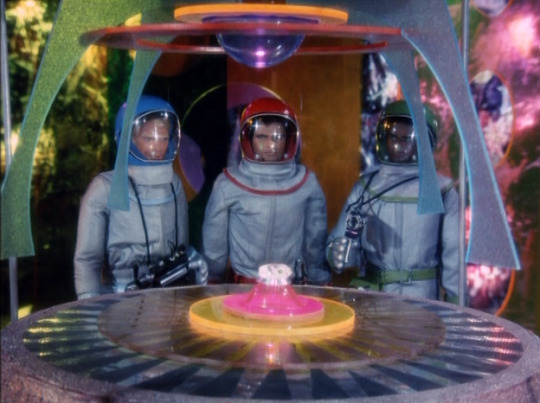
So this ep is pretty much a sequel to Lunarville 7, and is followed up with Dangerous Rendezvous. Neither of those made the cut of my list though, and even isolated from those it makes a solid story. The most Space-y of all the episodes and a visual treat, cause while we mostly stuck to the stark accommodations of Lunarville 7 in that episode, here we see the grey grimy gloom of the outside of the Moon, and the sharp, delightful contrast of the Mysteron’s fantastic plastic Complex. Here, vivid marbled colours and flashing lights join inorganic shapes that suggest something of the Mysteron’s nature, but as always, nothing conclusive.
Moving away from the lovely Aesthetics, this is also a strong one for characterisation. We get some sweet interactions with The Lads and for this episode only, the Best Female Character in the whole show. Linda Nolan is the controller of Lunarville 6, a smart, capable woman who had her own cool space mission referenced and in fact critical to the plot. She is also relatable in that she catches feelings for Scarlet, so while she’s barking up the wrong tree I still have nothing but respect for her, hehee.
Eerie, tense, interesting and still somewhat funny, this is another episode that eeks into an even higher ranking list than 10, I could comfortably put it in 5 and mmmaybe 3. Though I’m not gonna be able to say definitively as the best episodes all bring something different to the table, and this may just be the strongest in the uniqueness regard.
Fire at Rig 15
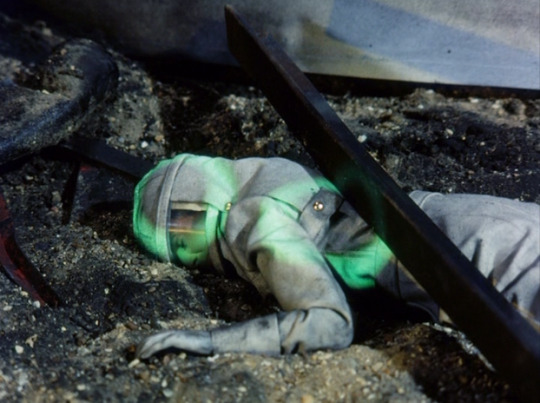
I get the feeling this may be an unorthodox choice, somehow? But yeah, I just really enjoy it. It’s not a funny episode, but it is rather exciting, and contains some lovely new music and a sweet scene at the end. The Mysteron’s plot is pretty simple, but should it succeed, devastating as it would be crippling Spectrum’s operations by removing the unique type of fuel all the craft uses.
In a way, it’s kind of like a dark mirror to a typical Thunderbirds setup; whereas in that show the initial fire would be more likely to be accidental or just maybe some ne’er do well like the Hood, this time it’s as simple as the Mysterons reopening the master valve. When traditional firefighters would eventually retreat to make room for International Rescue, here Spectrum themselves have a rather passive role as a professional rolls in. And of course, said man finds himself very, very dead due to further Mysteron interference (see picture), with Black seemingly hypnotising the poor bloke into standing too close to the explosion.
From there his duplicate half buries his original corpse and later receives direct instructions from Black to suicide bomb the nearby refinery, and it’s en route to this is where the thrilling car chase takes place! Scarlet saves the refinery but the whole SPV he was driving is completely ablaze at the end of it. Like my thoughts on Point 783, I really appreciate the human touch to the last scene, with soft music as arrangements are made for Scarlet to recover from the horrible state we’re spared of seeing. Seeing how his ability to recover from death is one of the cornerstones of the whole premise, I love it when we’re allowed a bit more insight into what the other Spectrum personnel do in the situations, in this case White specifically instructing Dr Fawn to make sure Scarlet is comfortable as the process takes place.
Treble Cross
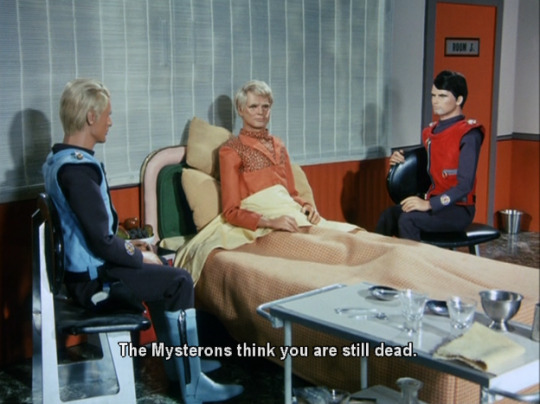
A notable and unique spin of an episode, where a rather routine Mysteron threat takes quite the turn when their assassinated target is brought back to life! It seems by the 2060′s we’ll have cool machinery to do CPR for a couple of hours as well as doctors ready to play god when they happen to drive by the car crash scene, heheh
Seriously though, this is a really fresh premise, that the villains who have been using doppelgangers for their devious schemes get the tables turned. This time the duplicate gets perma-killed while the original Major Gravener willingly participates in an undercover mission to help draw Captain Black into a trap at last... However, an easily overlooked factor in the driver who was also killed had been duplicated offscreen, so even with this amazing chance Spectrum can’t catch Black. But the World Capital, Futura City, is saved and Spectrum find the Mysterons themselves can’t tell their own copies from the original person, so it’s all in all a net gain!
Also this episode contains the World’s Happiest Clock, so that’s a neat plus.
Flight 104
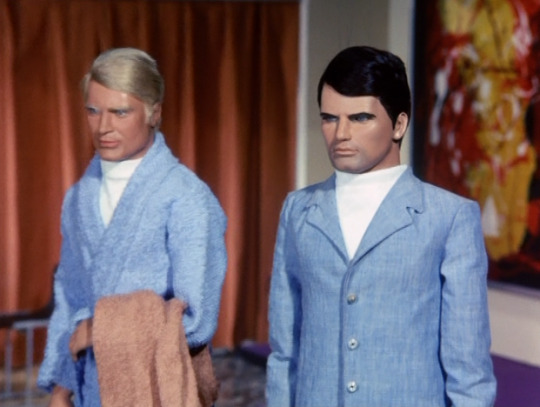
We start this story on the incredible note of Captain Blue singing in the shower of the Hotel room he shares with Captain Scarlet. Scarlet then orders them both room service for some lunch. And if that sounds like the start of a fanfic plot, it may well be, but it’s also literally right there in the episode, baybee!
Charmingly domestic opening aside, I love this whole shebang. Again it’s the usual Mysterons threatening of an individual who Spectrum are bodyguarding, but the way both our heroes and villains go about this is different from the norm. Scarlet and Blue are trying to avoid drawing attention, so they spend the whole episode in normal clothes (Blue spending 1/3 of this in that comfy bathrobe!), and don’t have their comms. What’s more, they get a pair of reporters suspicious, and the two trail them looking for a Big Scoop.
When I was first watching this, I was expecting the journalists to get killed by Black to be the Mysteron Pawns, but no! They’re both fine from the start to the end! Then we find Black doing ....something.... to the Flight Crew of the titular Flight 104, but they aren’t killed either, just drugged. Instead, the Mysterons remotely pilot the plane on a slow collision course with the Alps, but are undone when an Electrical Plant interferes with their control.
As breaking into the pilot cabin had the side effect of jamming the landing gear, the plane has to crash land at the airport, but almost everyone being unharmed makes this one of the most gentle episodes of the lot... of course, Scarlet himself is still heavily implied to have been killed from the crash, but even his injuries seem pretty minor this time. And yet, it’s not lacking in excitement, as the tension of Spectrum trying to communicate with the two without their Comms and the inability to override the Mysteron’s control until that pre-established Electrical weakness kicks in holds for a while.
Inferno

Those who know of me from Thunderbirds are Go (the 2015 TV series) discussion are likely to know how much I love the episode from Season 1, Tunnels of Time. It heavily features my favourite ship in that show as they explore an ancient South American Temple which is full of peril. The temple is destroyed by the end of the episode.
So anyway, Inferno features my favourite ship in this show as they explore an ancient South American Temple which is full of peril, and tragically the temple is destroyed by the end of the episode! Heheeheheee~
Ok seriously though, eerie parallels aside this is another utterly beautiful instalment, with set design and lighting that really blows other episodes out of the proverbial water. And the pyrotechnic team clearly had fun with the seemingly unending explosions at the end of the adventure. An all-around visual feast!
Main plot is relatively simple, like in White as Snow, the Mysterons kill a Satellite and its crew and steer the reconstructed version towards their target of the week. Unlike WaS, they succeed in the end, a reminder that they’re still not to be underestimated. No human lives are lost, but the important complex and more tragically, the 800 year old temple that’s otherwise intact, get bombed to smithereens. Something something additional cost of warfare on Culture and History.
But while this is the end of my personal Top 10 list, it’s not all bad, because the Scarlet and Blue antics in the temple are utterly lovely and [chef finger kiss] splendid cinema~!

That about wraps up this Two-part post of mine! Picking 10 out of 32 is easier than 10 out of 100, but it’s still tricky as most of the episodes are very good, with only a few I’d promptly write off as a candidate for the list. And in some ways I wonder if I went about this the right way, some eps I only saw once and might feel strong enough to pip one’a the ones I did choose.
I have been rewatching each of the eps covered, and a few that didn’t make it, but my initial choice was made looking at the full list and letting my gut grab a few, having to think over more as the slots filled. Some fan favourites like Lunarville 7 came close, but I hope I’ve been able to clearly convey what it is about this selection that gave them the edge ;3
I will write further posts on Captain Scarlet and the Mysterons in the future, but after this mammoth and also the Notable Episodes list I’d quite like to enjoy it for a while without thinking about points to talk about, haha
8 notes
·
View notes